Rhode Island may be the smallest state in the United States, but it is home to a diverse array of wildlife. During the winter months, one can witness the arrival of various bird species that call Rhode Island their seasonal home.
From the majestic Bald Eagle to the tiny and energetic Dark-eyed Junco, these winter birds bring life and vitality to the otherwise chilly and snow-covered landscapes.
The vibrant colors, melodious tunes, and remarkable adaptations of these feathered residents make winter birdwatching a captivating experience in Rhode Island.
In this article, we will explore some of the fascinating winter birds that can be found in this picturesque New England state, highlighting their behaviors, habitats, and the best places to observe them.
45 Winter Birds In Rhode Island
Rhode Island is home to a variety of winter birds, both resident species and migratory visitors that arrive during the colder months. Here are 45 winter birds you might spot in Rhode Island
1. Downy Woodpecker (Picoides pubescens)
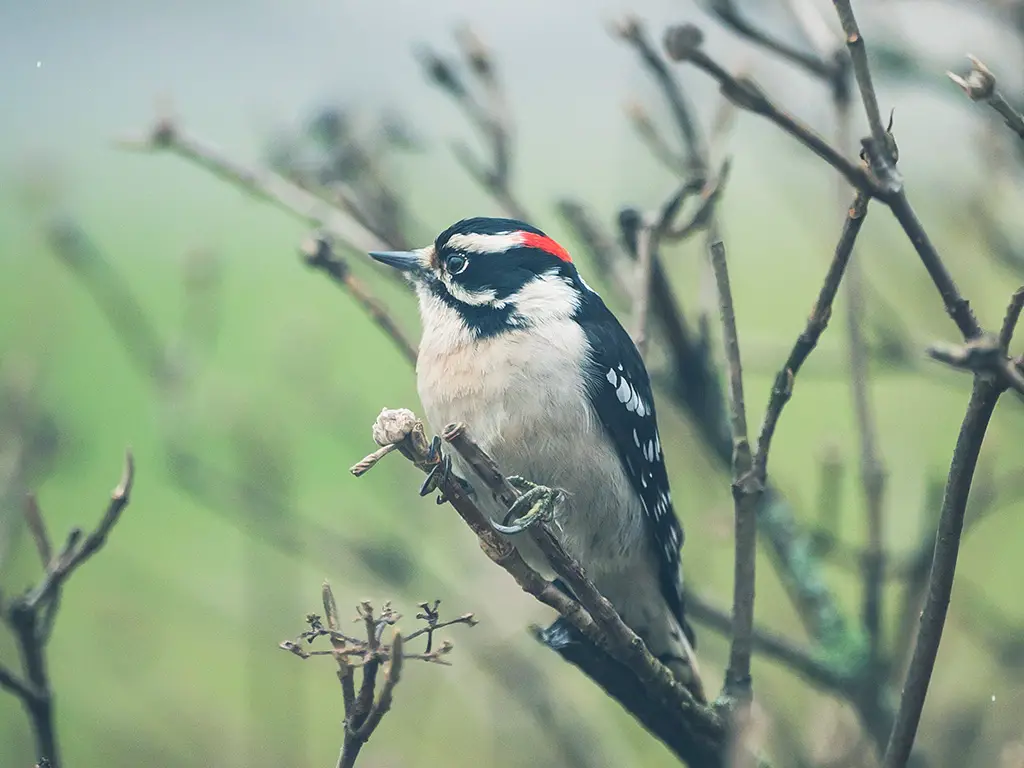
The Downy Woodpecker (Picoides pubescens) is North America’s smallest woodpecker, measuring between 14 to 18 cm in length.
These charming birds are widely distributed across the United States and Canada, making their homes in various forested habitats.
They are adaptable and resilient, with the ability to thrive in diverse ecosystems. Downy woodpeckers boast distinctive black and white plumage, and both males and females exhibit a small, pointed bill.
Their primary diet consists of insects, larvae, and tree sap, which they extract using their specialized tongues. Their rhythmic drumming and distinct calls add a delightful element to the woodland chorus.
| Kingdom | Animalia |
| Phylum | Chordata |
| Clade | Dinosauria |
| Class | Aves |
| Order | Piciformes |
| Family | Picidae |
| Genus | Dryobates |
| Species | D. pubescens |
2. White-Breasted Nuthatch (Sitta carolinensis)
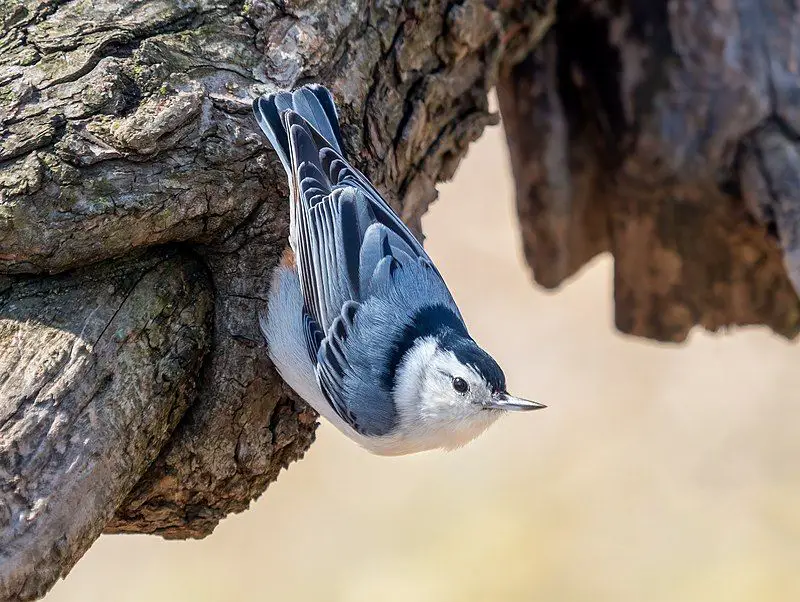
The White-breasted Nuthatch (Sitta carolinensis) is a delightful member of the nuthatch family, Sittidae. These medium-sized birds measure around 15.5 cm in length and are recognized for their distinctive appearance and behavior.
With a striking black cap, white face, and a robust, bluish-gray back, they are easily identifiable. White-breasted nuthatches are agile climbers, known for their ability to move headfirst down tree trunks, thanks to their strong toes and sharp bills.
They have a fondness for insects, seeds, and nuts, and their nasal “yank-yank” calls are often heard as they forage for food in woodlands and suburban areas across North America.
| Kingdom | Animalia |
| Phylum | Chordata |
| Clade | Dinosauria |
| Class | Aves |
| Order | Passeriformes |
| Family | Sittidae |
| Genus | Sitta |
| Species | S. carolinensis |
3. House Finch (Haemorhous mexicanus)
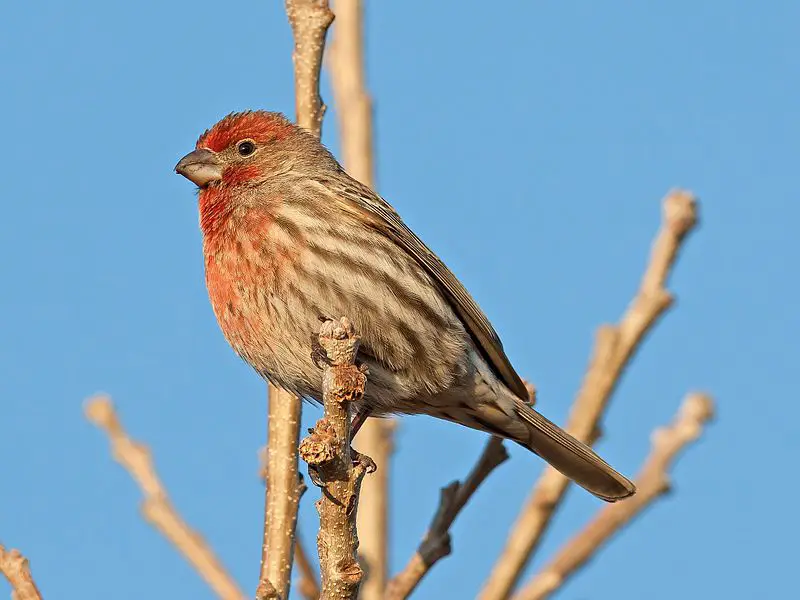
The House Finch (Haemorhous mexicanus) is a charming member of the finch family, Fringillidae. Originally native to western North America, it has successfully expanded its range, being introduced to the eastern half of the continent and Hawaii.
House Finches exhibit remarkable adaptability, thriving in urban, suburban, and rural environments. These small birds are typically around 15 cm in length and are known for their delightful singing, making them a common presence around bird feeders.
Males sport vibrant red plumage on their heads and throats, while females display more subdued brownish hues. Their ability to coexist with humans has earned them the nickname “Hollywood finch.”
| Kingdom | Animalia |
| Phylum | Chordata |
| Clade | Dinosauria |
| Class | Aves |
| Order | Passeriformes |
| Family | Fringillidae |
| Genus | Haemorhous |
| Species | H. mexicanus |
4. Tufted Titmouse (Baeolophus bicolor)
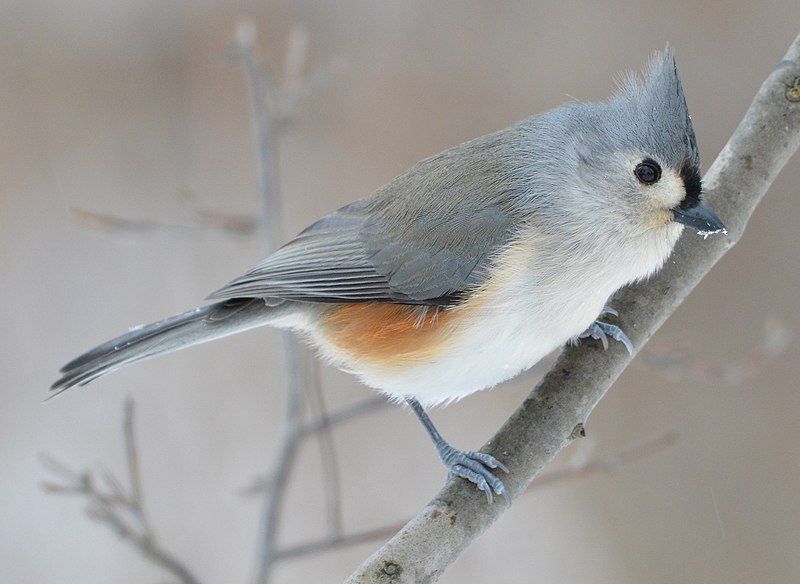
The Tufted Titmouse (Baeolophus bicolor) is a delightful small songbird native to North America, belonging to the tit and chickadee family.
Known for its distinctive appearance and cheerful disposition, these birds are a common sight in woodlands and residential areas across their range.
Tufted Titmice are approximately 15 cm in length and boast gray plumage, a signature crest on their head, and a splash of peachy color on their flanks.
They are social birds often seen in pairs or small flocks, with a varied diet that includes insects, seeds, berries, and nuts. Their clear, whistled “peter-peter-peter” call adds a delightful note to the avian chorus.
| Kingdom | Animalia |
| Phylum | Chordata |
| Clade | Dinosauria |
| Class | Aves |
| Order | Passeriformes |
| Family | Paridae |
| Genus | Baeolophus |
| Species | B. bicolor |
5. American Robin (Turdus migratorius)
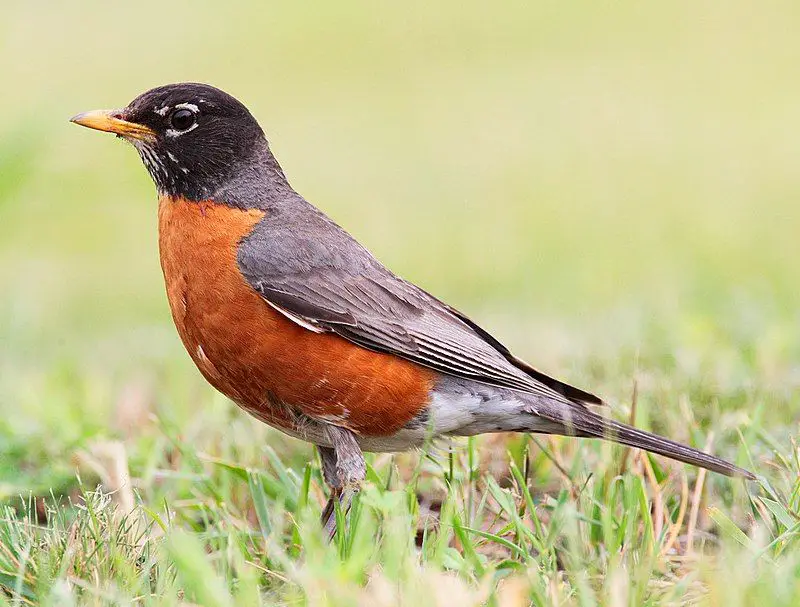
The American Robin (Turdus migratorius) is one of North America’s most recognizable and beloved birds. Renowned for its distinctive orange-red breast and grayish-brown upper parts, these medium-sized thrushes are a harbinger of spring in many regions.
American Robins are highly adaptable and can be found in a variety of habitats, from forests to urban gardens. Their diet primarily consists of insects, earthworms, and fruits, making them a valuable part of the ecosystem.
Their melodious, flute-like song fills the air during the spring and summer months, and they’re often associated with the arrival of warmer weather, making them a cherished symbol of renewal and hope.
| Kingdom | Animalia |
| Phylum | Chordata |
| Clade | Dinosauria |
| Class | Aves |
| Order | Passeriformes |
| Family | Turdidae |
| Genus | Turdus |
| Species | T. migratorius |
6. American Goldfinch (Spinus tristis)
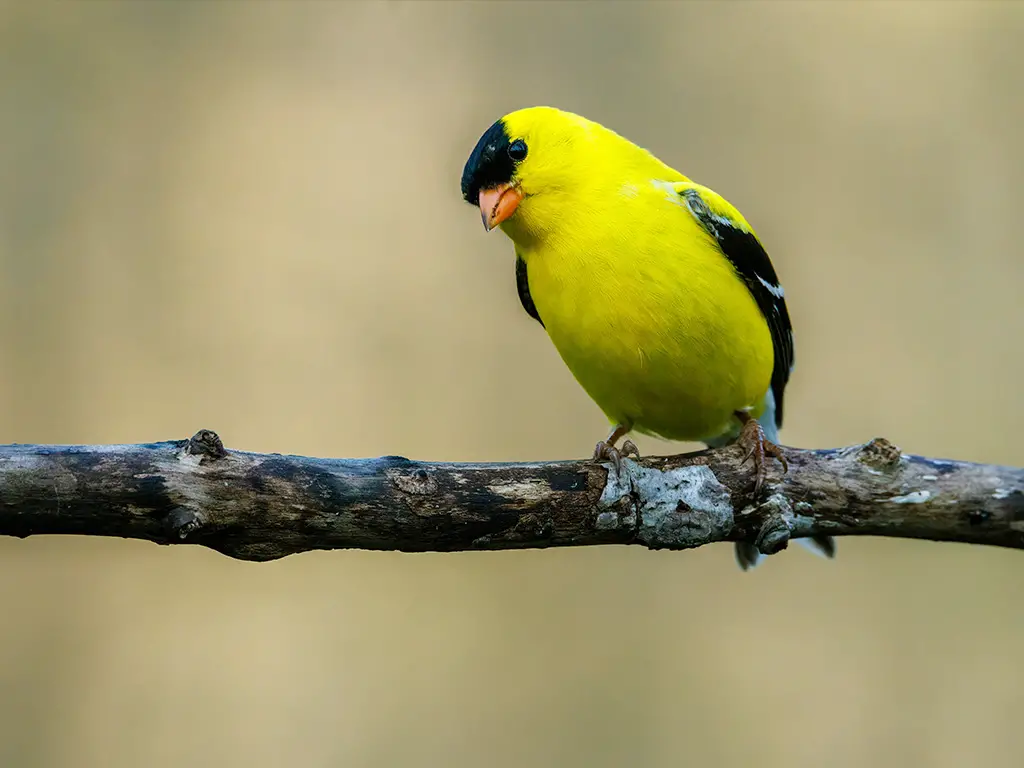
The American Goldfinch (Spinus tristis) is a strikingly beautiful bird native to North America. Known for its vibrant plumage and cheerful demeanor, these small finches brighten landscapes across the continent.
During the breeding season, males display brilliant yellow feathers, contrasting with a striking black cap and wings. American Goldfinches primarily feed on seeds, especially from thistle plants.
They’re often seen perched on flowers or swaying in flight, adding a touch of color to gardens and meadows. These sociable birds form flocks and their delightful, high-pitched songs are a common sound in the summer, making them a welcome presence in any backyard.
| Kingdom | Animalia |
| Phylum | Chordata |
| Clade | Dinosauria |
| Class | Aves |
| Order | Passeriformes |
| Family | Fringillidae |
| Genus | Spinus |
| Species | S. tristis |
7. Black-Capped Chickadee (Poecile atricapillus)
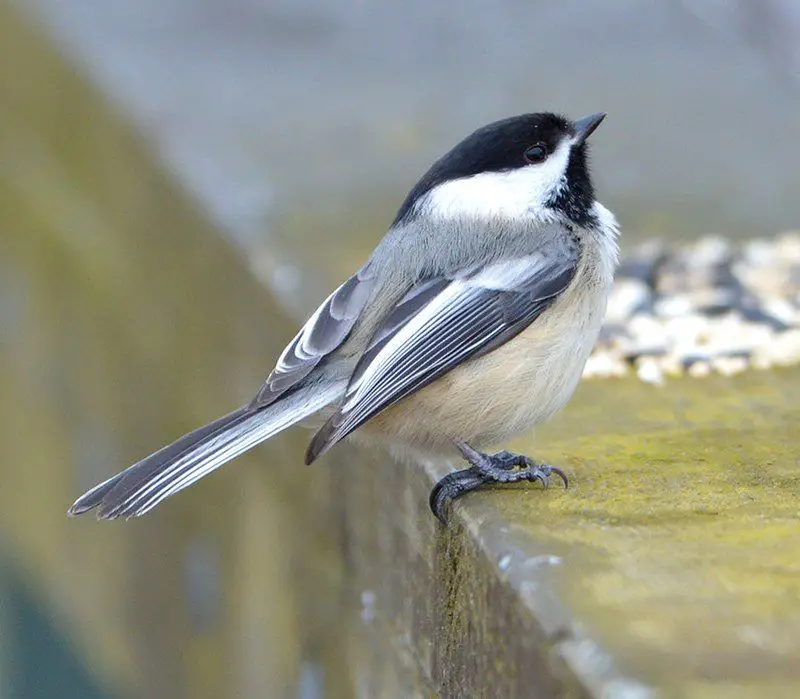
The Black-Capped Chickadee, a small, charming bird, is easily recognizable by its distinctive black cap and bib, white cheeks, and fluffy appearance.
Native to North America, these birds are adaptable, thriving in both wild forests and suburban areas. Measuring about 5 inches in length, they exhibit remarkable curiosity and are known for their cheerful, complex vocalizations including the familiar “chick-a-dee-dee-dee” call.
In winter, they exhibit remarkable memory for recalling hidden food locations. Their diet mainly consists of insects, seeds, and berries, making them a welcome visitor to backyard feeders.
| Kingdom | Animalia |
| Phylum | Chordata |
| Clade | Dinosauria |
| Class | Aves |
| Order | Passeriformes |
| Family | Paridae |
| Genus | Poecile |
| Species | P. atricapillus |
8. Blue Jay (Cyanocitta cristata)
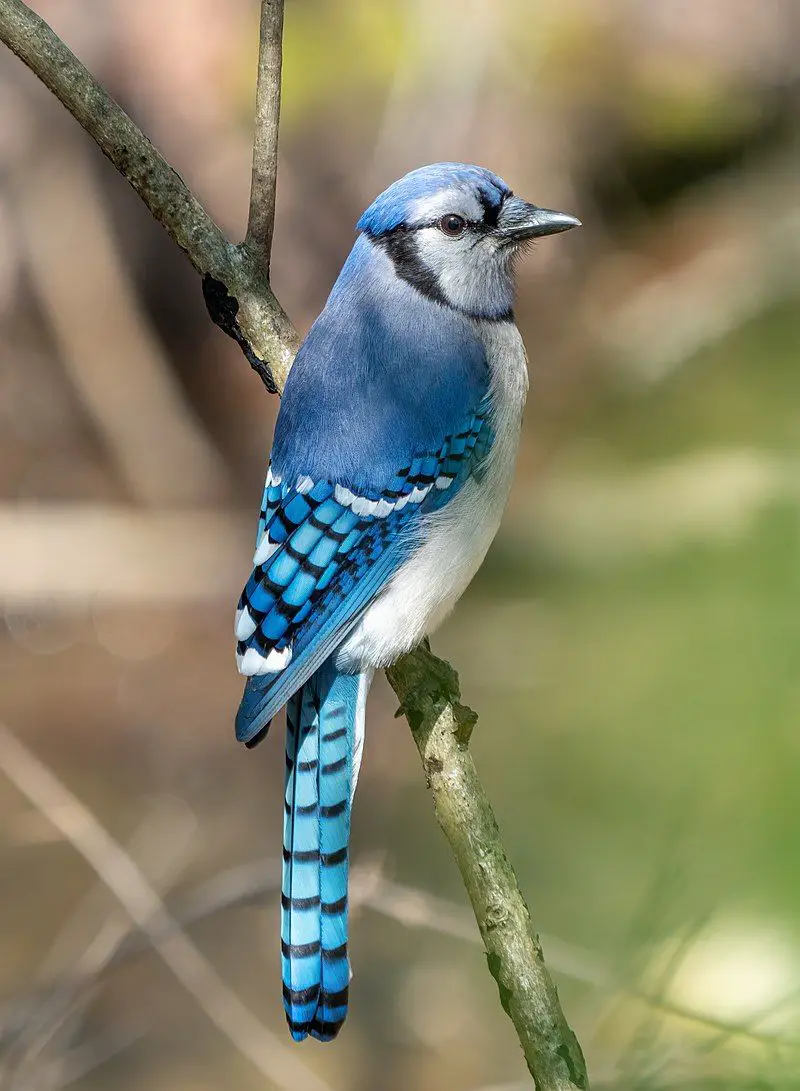
The Blue Jay, scientifically known as Cyanocitta cristata, is a striking and intelligent bird native to North America.
With its vibrant blue plumage, white chest, and distinctive black markings on its face and wings, the Blue Jay is a visually captivating species.
Known for its loud and melodious calls, it is an excellent mimic of other bird sounds and often exhibits a mischievous personality.
Blue Jays are opportunistic omnivores, feeding on a wide range of foods including seeds, insects, fruits, and even small vertebrates. They are known for their habit of caching food for later consumption.
These adaptable and resourceful birds are a common sight in urban and suburban areas, adding a splash of color and vocal charm to the natural world around us.
| Kingdom | Animalia |
| Phylum | Chordata |
| Clade | Dinosauria |
| Class | Aves |
| Order | Passeriformes |
| Family | Corvidae |
| Genus | Cyanocitta |
| Species | C. cristata |
9. Common Starling (Sturnus vulgaris)
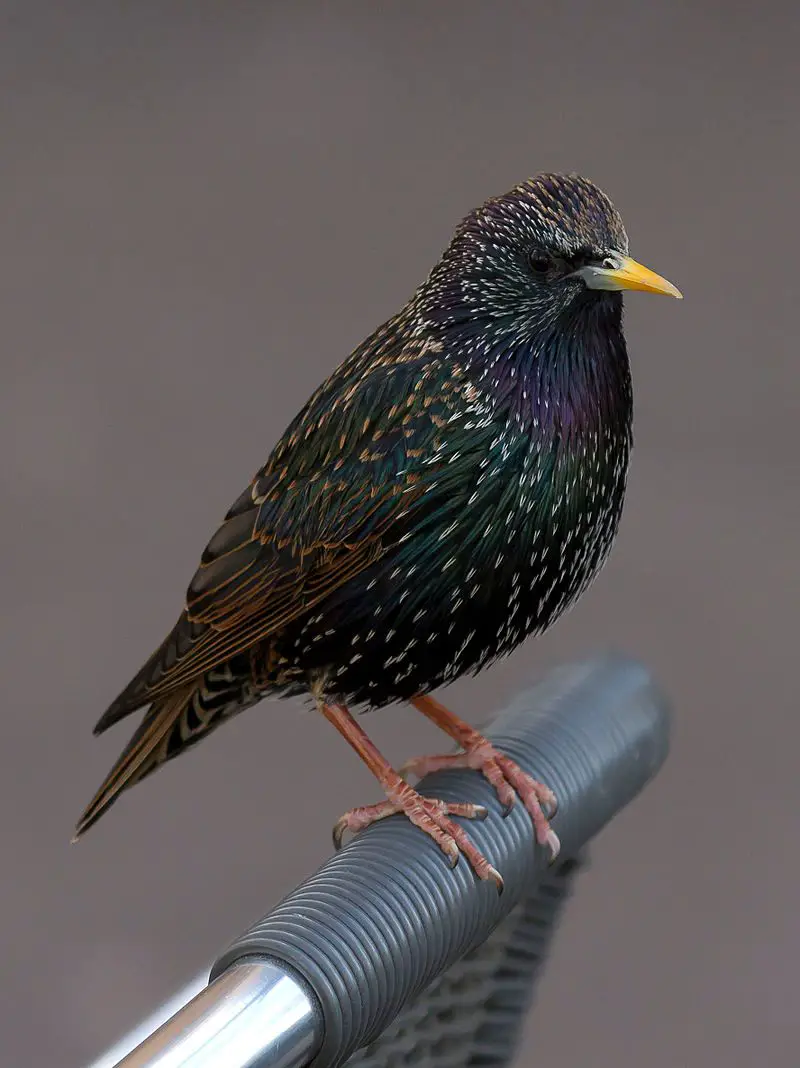
The common starling (Sturnus vulgaris) is a bird that belongs to the starling family, Sturnidae. It is native to Europe, Asia, and Africa, but has been introduced to many other parts of the world.
It has a glossy black plumage with a metallic sheen, which is speckled with white in some seasons.
It has a short tail, a long and pointed bill, and pink legs. It is a noisy and social bird that can mimic other sounds and form large flocks. It feeds on insects, seeds and fruits, and builds its nest in cavities.
| Kingdom | Animalia |
| Phylum | Chordata |
| Clade | Dinosauria |
| Class | Aves |
| Order | Passeriformes |
| Family | Sturnidae |
| Genus | Sturnus |
| Species | S. vulgaris |
10. Song Sparrow (Melospiza melodia)
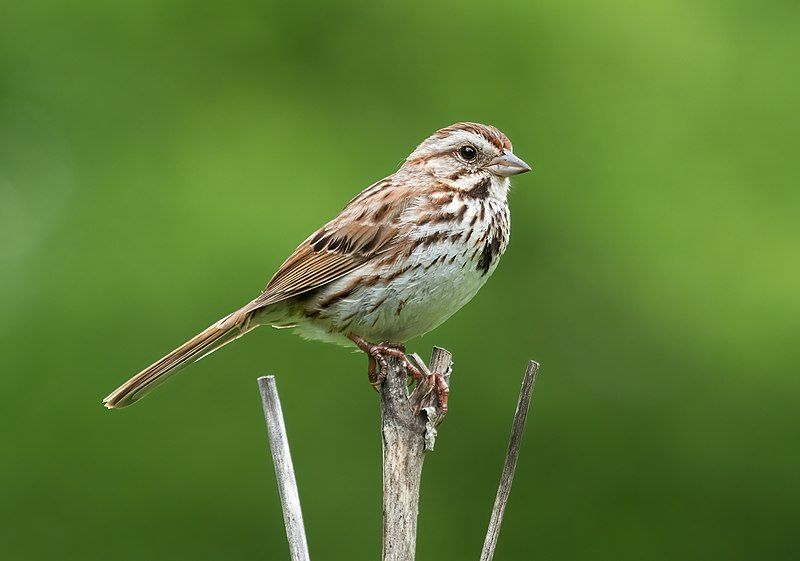
The song sparrow (Melospiza melodia) is a widespread bird in North America. It has a brown and gray plumage with bold streaks on its white chest. It lives in open, shrubby, or wet habitats, where it feeds on seeds, insects, and berries.
It is known for its varied and musical song, which it sings from a low perch or a wire. The song sparrow has many regional variations in appearance and song, with 24 recognized subspecies and 52 forms.
| Kingdom | Animalia |
| Phylum | Chordata |
| Clade | Dinosauria |
| Class | Aves |
| Order | Passeriformes |
| Family | Passerellidae |
| Genus | Melospiza |
| Species | M. melodia |
11. Red-Breasted Nuthatch (Sitta canadensis)
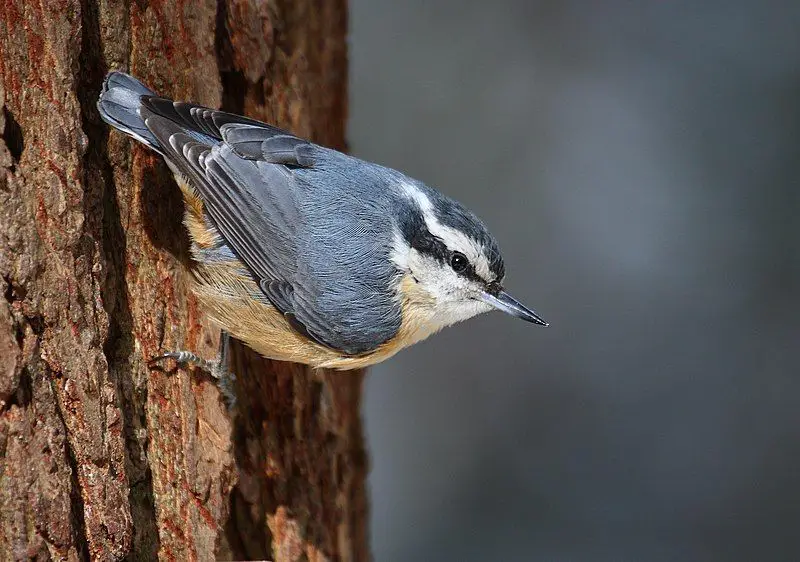
The red-breasted nuthatch is a small bird that lives in the forests of North America. It has a black stripe through its eye, a white stripe above it, and a black cap on its head. Its back and wings are blue-gray, and its chest and belly are reddish-brown.
It has a long, straight bill that it uses to probe for insects in the bark of trees. It can climb up and down tree trunks and branches with ease, unlike most birds that can only go up.
It makes a loud, nasal sound that sounds like a toy horn. It is often seen with other birds such as chickadees and woodpeckers.
| Kingdom | Animalia |
| Phylum | Chordata |
| Clade | Dinosauria |
| Class | Aves |
| Order | Passeriformes |
| Family | Sittidae |
| Genus | Sitta |
| Species | S. canadensis |
12. Northern Cardinal ( Cardinalis cardinalis)
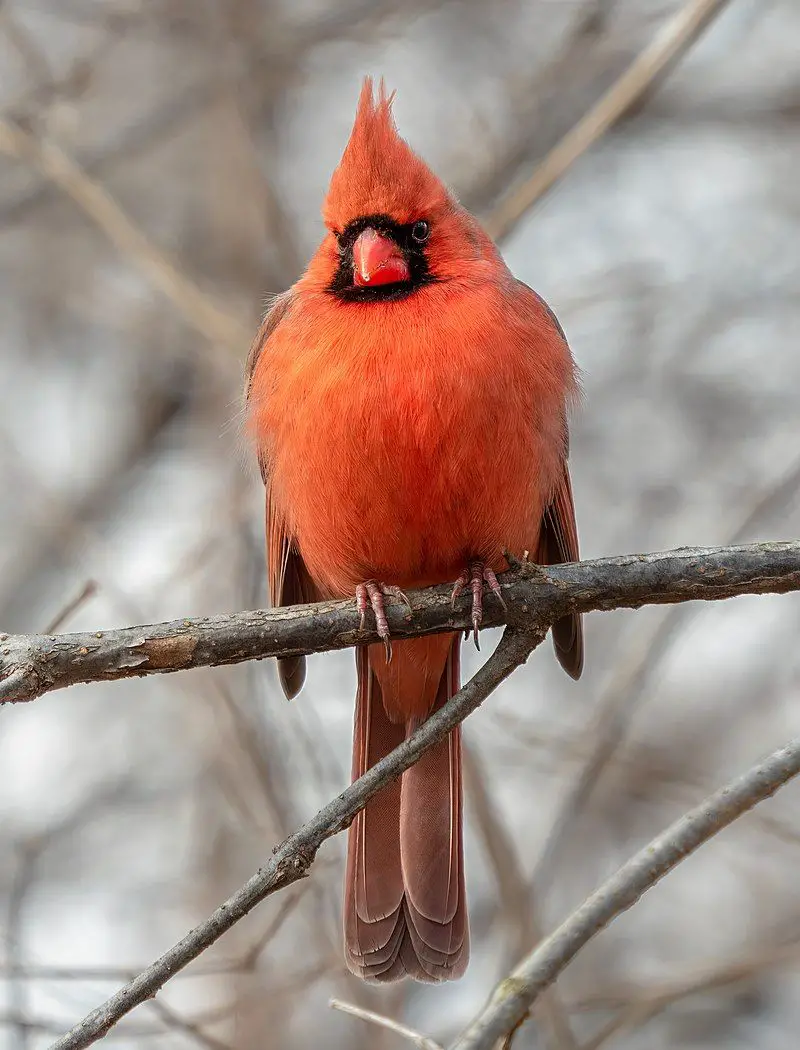
The northern cardinal (Cardinalis cardinalis) is a bird that belongs to the family Cardinalidae, which includes other colorful birds such as tanagers, grosbeaks, and buntings.
The northern cardinal is found in southeastern Canada, eastern and southern United States, Mexico, and parts of Central America. It has also been introduced to Bermuda, Hawaii, and California.
The northern cardinal is a medium-sized songbird with a short, thick bill and a distinctive crest on its head.
The male is bright red with a black mask on its face, while the female is brownish with red accents and a gray mask. The northern cardinal feeds mainly on seeds, fruits, and insects.
It sings a clear, whistled song that varies among individuals and regions. The northern cardinal is a popular bird among birdwatchers and backyard feeders.
It is the state bird of seven U.S. states: Illinois, Indiana, Kentucky, North Carolina, Ohio, Virginia, and West Virginia.
| Kingdom | Animalia |
| Phylum | Chordata |
| Clade | Dinosauria |
| Class | Aves |
| Order | Passeriformes |
| Family | Cardinalidae |
| Genus | Cardinalis |
| Species | C. cardinalis |
13. White-Throated Sparrow (Zonotrichia albicollis)
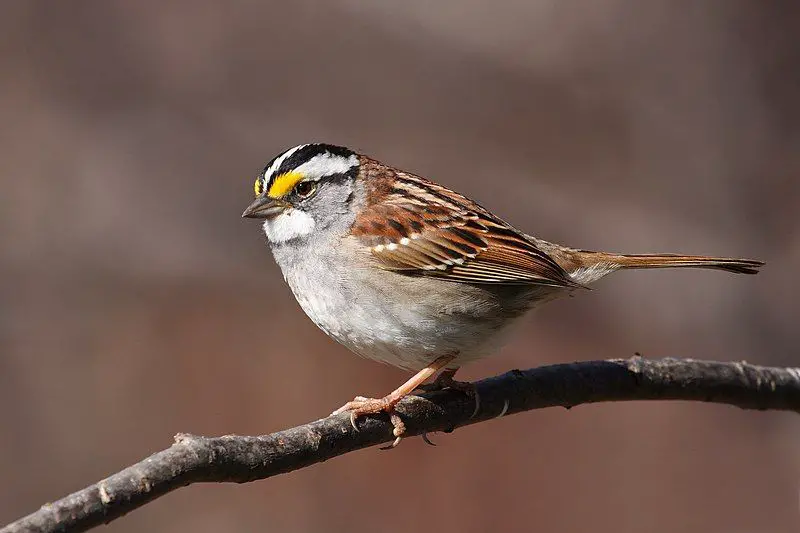
The white-throated sparrow is a small bird that belongs to the New World sparrow family. It has a distinctive white throat patch, a black stripe on its white crown, and yellow patches near its eyes. It is also known for its beautiful song, which sounds like “Oh-sweet-Canada”.
The white-throated sparrow breeds mostly in Canada, but it migrates to the eastern and southern parts of the United States and California in winter.
It prefers to live in forested areas, where it feeds on seeds, insects, and berries. It often forms loose flocks with other sparrows and visits bird feeders near thickets.
| Kingdom | Animalia |
| Phylum | Chordata |
| Clade | Dinosauria |
| Class | Aves |
| Order | Passeriformes |
| Family | Passerellidae |
| Genus | Zonotrichia |
| Species | Z. albicollis |
14. Rusty Blackbird (Euphagus carolinus)
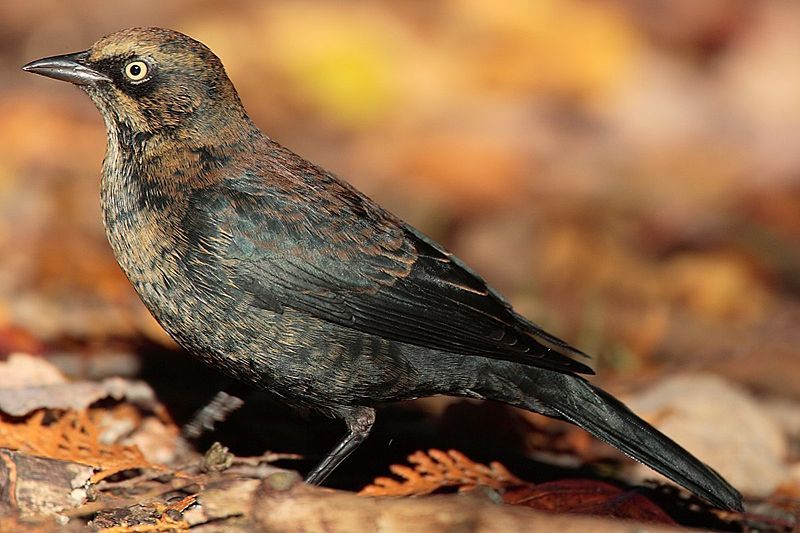
The rusty blackbird (Euphagus carolinus) is a medium-sized songbird that belongs to the icterid family, along with other blackbirds, grackles, orioles, and meadowlarks. It has pale yellow eyes and a slender black bill that is slightly curved.
The male is glossy black in the breeding season, while the female is brownish gray. In the winter, both sexes have rusty edges on their feathers, giving them their common name.
The rusty blackbird breeds in wet forested areas, such as boreal forests and muskegs, across northern Canada and Alaska.
It migrates to the eastern and southern United States in the winter, where it prefers swampy habitats with dense vegetation.
The rusty blackbird feeds mainly on insects, seeds, and aquatic invertebrates. It often forages on the ground or in shallow water, flipping over leaves and debris to find food.
The rusty blackbird is one of the most rapidly declining bird species in North America, with an estimated population decline of 85-99% over the past 40 years.
The causes of this decline are not well understood but may include habitat loss, climate change, pollution, disease, and competition from other blackbirds.
| Kingdom | Animalia |
| Phylum | Chordata |
| Clade | Dinosauria |
| Class | Aves |
| Order | Passeriformes |
| Family | Icteridae |
| Genus | Euphagus |
| Species | E. carolinus |
15. Red-bellied Woodpecker (Melanerpes Carolinus)
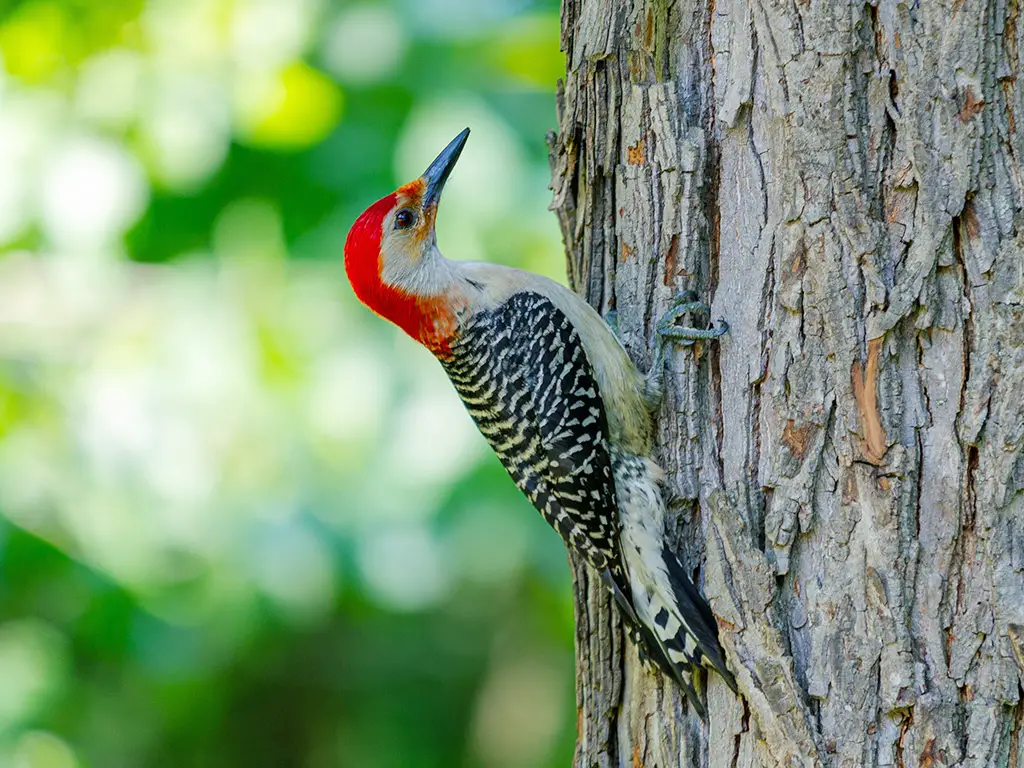
The Red-bellied Woodpecker (Melanerpes carolinus) is a vibrant and energetic bird inhabiting the eastern and southern United States.
Despite its misleading name, its belly displays only a slight reddish tinge, while its striking feature is the vivid red cap on its head.
These medium-sized woodpeckers are skilled climbers and foragers, utilizing their sturdy bills to excavate insects, fruits, and seeds from tree bark.
Their unmistakable rolling “churrr” call resonates through the woodlands, alerting enthusiasts to their presence.
Red-bellied Woodpeckers are known for visiting bird feeders, adding a touch of excitement to backyard birdwatching and becoming cherished residents in suburban and forested areas alike.
| Kingdom | Animalia |
| Phylum | Chordata |
| Clade | Dinosauria |
| Class | Aves |
| Order | Piciformes |
| Family | Picidae |
| Genus | Melanerpes |
| Species | M. carolinus |
16. Northern Mockingbird (Mimus polyglottos)
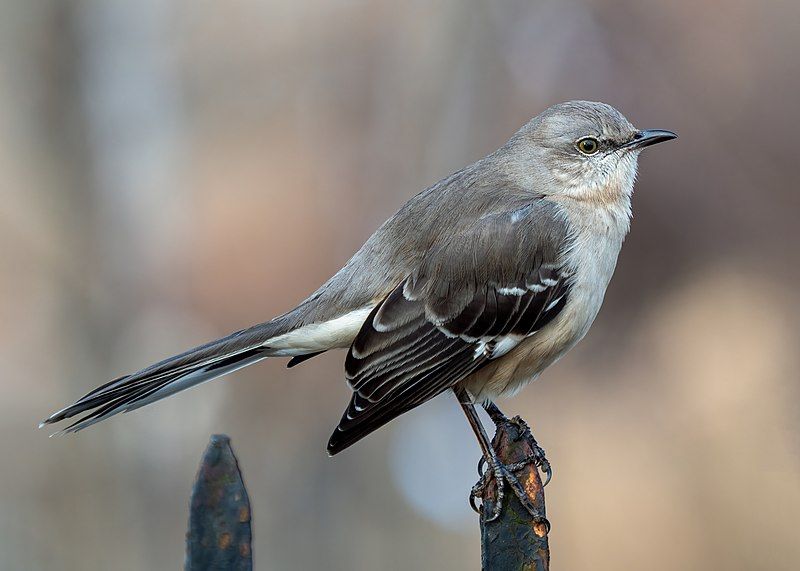
| Kingdom | Animalia |
| Phylum | Chordata |
| Clade | Dinosauria |
| Class | Aves |
| Order | Passeriformes |
| Family | Mimidae |
| Genus | Mimus |
| Species | M. polyglottos |
17. Cooper’s Hawk (Accipiter cooperii)
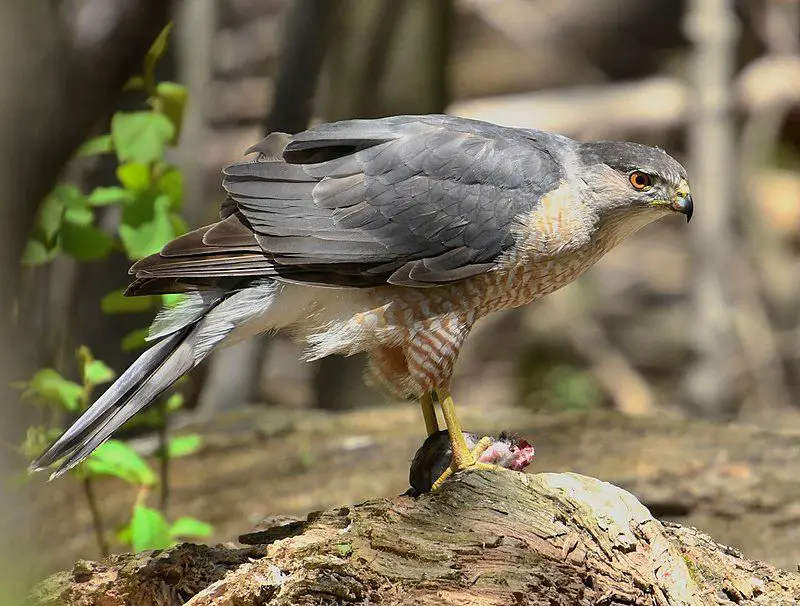
The Cooper’s Hawk is a medium-sized raptor found across North America. Distinguished by its slate-gray plumage, striking red eyes, and distinctive banded tail, these birds of prey are agile and skilled hunters.
Cooper’s Hawks are known for their adaptation to various environments, from woodlands to urban areas, where they hunt birds and small mammals with precision. With swift and stealthy flights through dense vegetation, they surprise their prey.
Although often confused with their close relative, the Sharp-shinned Hawk, Cooper’s Hawks are an integral part of the ecosystem, playing a vital role in maintaining the balance of avian populations.
| Kingdom | Animalia |
| Phylum | Chordata |
| Clade | Dinosauria |
| Class | Aves |
| Order | Accipitriformes |
| Family | Accipitridae |
| Genus | Accipiter |
| Species | A. cooperii |
18. Great Blue Heron (Ardea Herodias)

The Great Blue Heron (Ardea herodias) is a majestic wading bird found throughout North America. Recognized by its towering stature, it can reach heights of up to four feet with a wingspan exceeding six feet.
Its plumage is predominantly gray-blue, and it boasts a long, slender neck, and a dagger-like bill designed for capturing fish and other aquatic prey.
These patient hunters often stand motionless in shallow waters or wetlands, waiting for the perfect moment to strike with lightning speed.
Great Blue Herons are icons of grace and tranquility in wetland habitats, symbolizing the natural beauty of their surroundings.
| Kingdom | Animalia |
| Phylum | Chordata |
| Clade | Dinosauria |
| Class | Aves |
| Order | Pelecaniformes |
| Family | Ardeidae |
| Genus | Ardea |
| Species | A. herodias |
19. Double-Crested Cormorant (Phalacrocorax auritus)
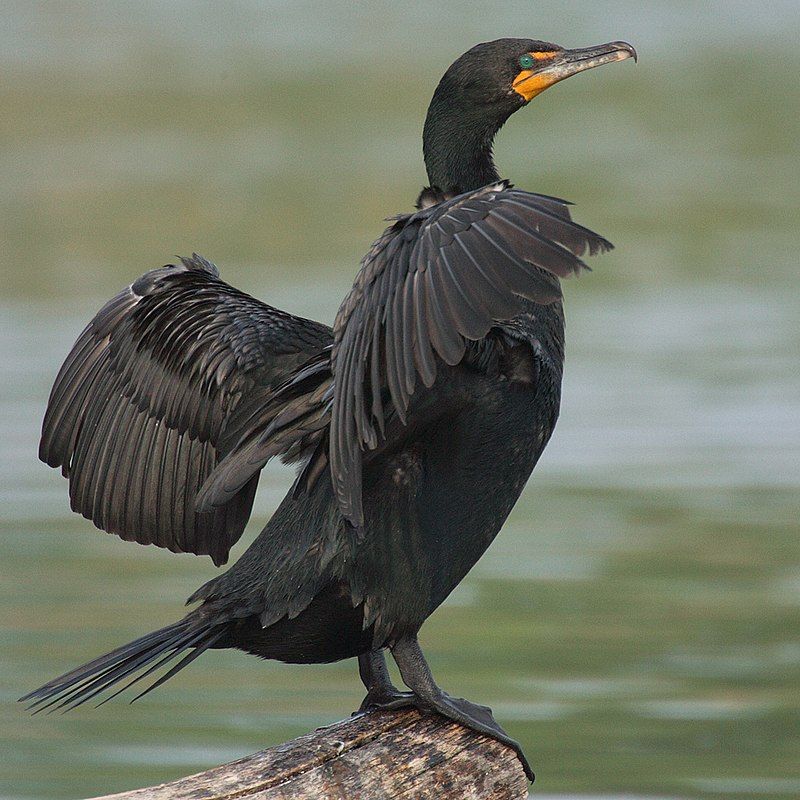
The Double-Crested Cormorant is a waterbird native to North America. It gets its name from the distinctive crests that develop during the breeding season.
These birds have striking black plumage, long necks, and webbed feet, making them excellent swimmers and divers. Double-crested cormorants primarily feed on fish, using their sharp bills to catch prey underwater.
They are often seen perched on rocks or tree branches with their wings outstretched to dry after swimming. These birds are widespread and are known for their remarkable fishing abilities and adaptability to a range of aquatic habitats.
| Kingdom | Animalia |
| Phylum | Chordata |
| Clade | Dinosauria |
| Class | Aves |
| Order | Suliformes |
| Family | Phalacrocoracidae |
| Genus | Nannopterum |
| Species | N. auritum |
20. Eastern Towhee ( Pipilo erythrophthalmus)
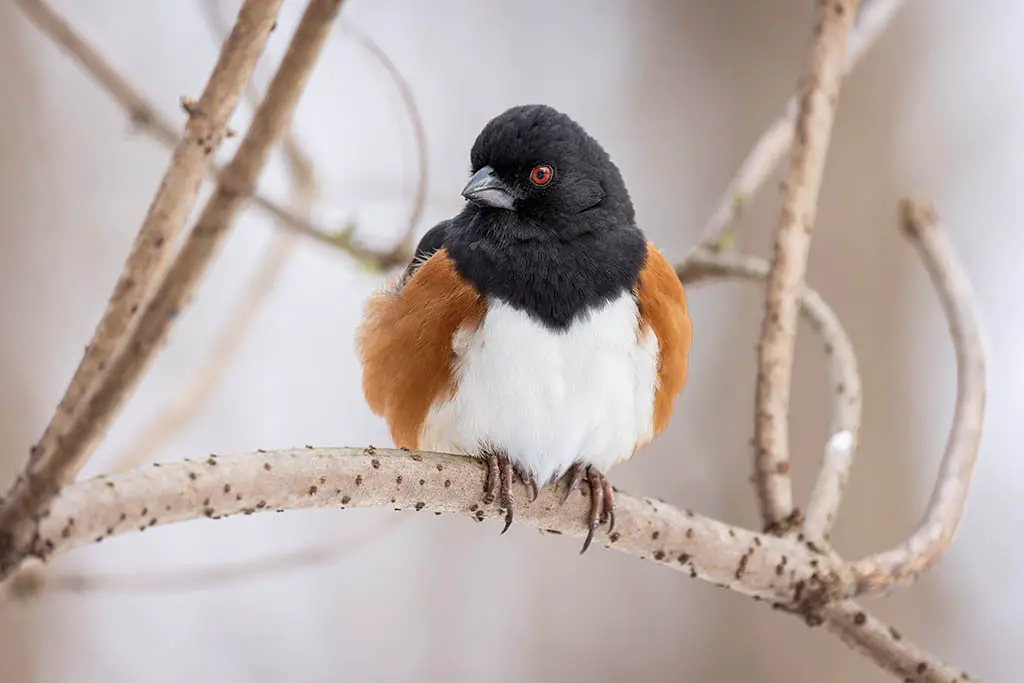
The Eastern Towhee (Pipilo erythrophthalmus) is a medium-sized sparrow found in eastern North America. It’s recognized by its distinctive plumage, with a black hood and throat, rufous sides, and a white belly.
Eastern Towhees forage on the ground, scratching through leaf litter to uncover insects, seeds, and vegetation. Their call, often described as “drink your tea,” is a common woodland sound during the breeding season.
These birds are secretive but can be spotted in thickets, brushy areas, and woodlands. Eastern Towhees are delightful additions to birdwatching experiences, bringing both visual and auditory charm to the outdoors.
| Kingdom | Animalia |
| Phylum | Chordata |
| Clade | Dinosauria |
| Class | Aves |
| Order | Passeriformes |
| Family | Passerellidae |
| Genus | Pipilo |
| Species | P. erythrophthalmus |
21. Canada Goose (Branta canadensis)
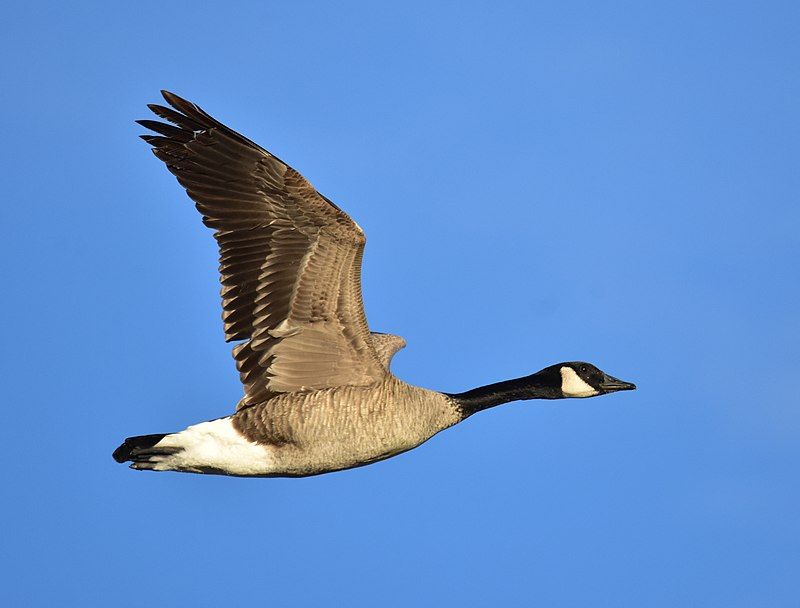
The Canada Goose (Branta canadensis) is one of North America’s most recognizable waterfowl species. These large, migratory birds have brownish-gray bodies, black necks, and distinctive white cheek patches.
Known for their V-shaped flight formations during migration, they travel vast distances between their breeding and wintering grounds. Canada Geese are often found in ponds, lakes, and rivers, where they feed on aquatic vegetation and graze in nearby fields.
Their distinctive, resonant “honking” calls are a familiar sound in many regions. These adaptable and sociable birds have become a symbol of wild spaces and are frequently encountered in urban and suburban areas as well.
| Kingdom | Animalia |
| Phylum | Chordata |
| Clade | Dinosauria |
| Class | Aves |
| Order | Anseriformes |
| Family | Anatidae |
| Genus | Branta |
| Species | B. canadensis |
22. Baltimore Oriole (Icterus galbula)
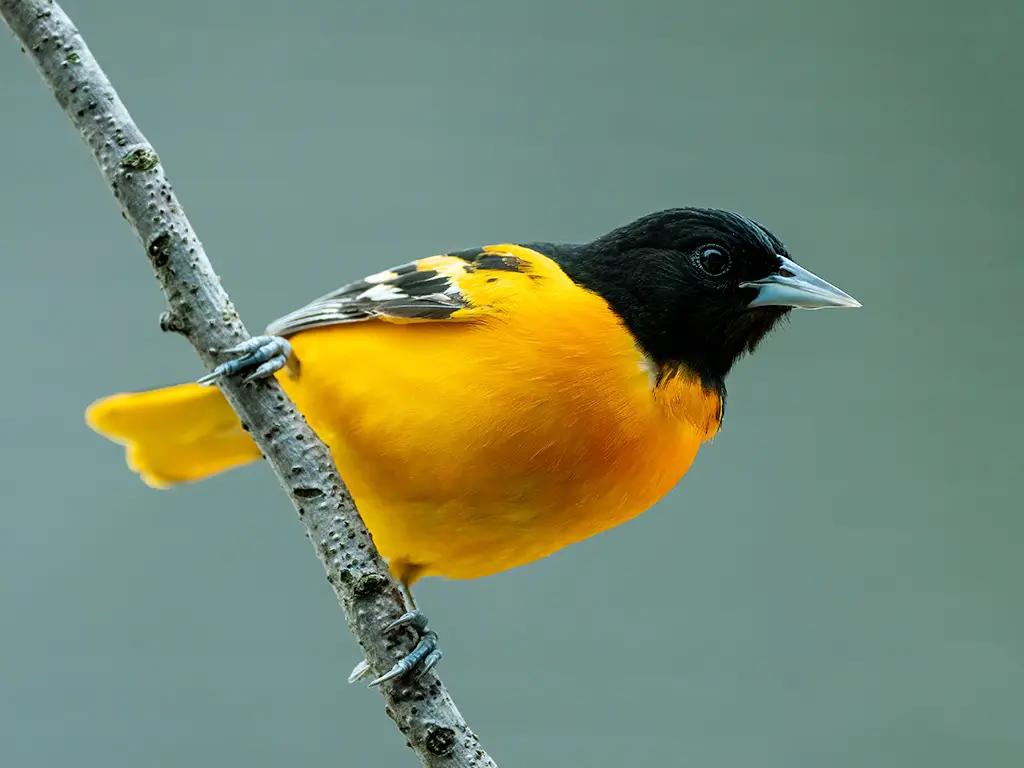
The Baltimore Oriole (Icterus galbula) is a vibrant songbird found in eastern North America during the summer months. Males are known for their brilliant orange plumage, while females have more subdued colors.
These birds are skilled weavers, crafting intricate hanging nests from plant fibers. They primarily feed on nectar, insects, and fruits and are attracted to sugary offerings like oranges and grape jelly.
Baltimore Orioles delight bird enthusiasts with their melodious songs and striking appearance, making them a symbol of summer’s arrival.
| Kingdom | Animalia |
| Phylum | Chordata |
| Clade | Dinosauria |
| Class | Aves |
| Order | Passeriformes |
| Family | Icteridae |
| Genus | Icterus |
| Species | I. galbula |
23. Northern Flicker (Colaptes auratus)
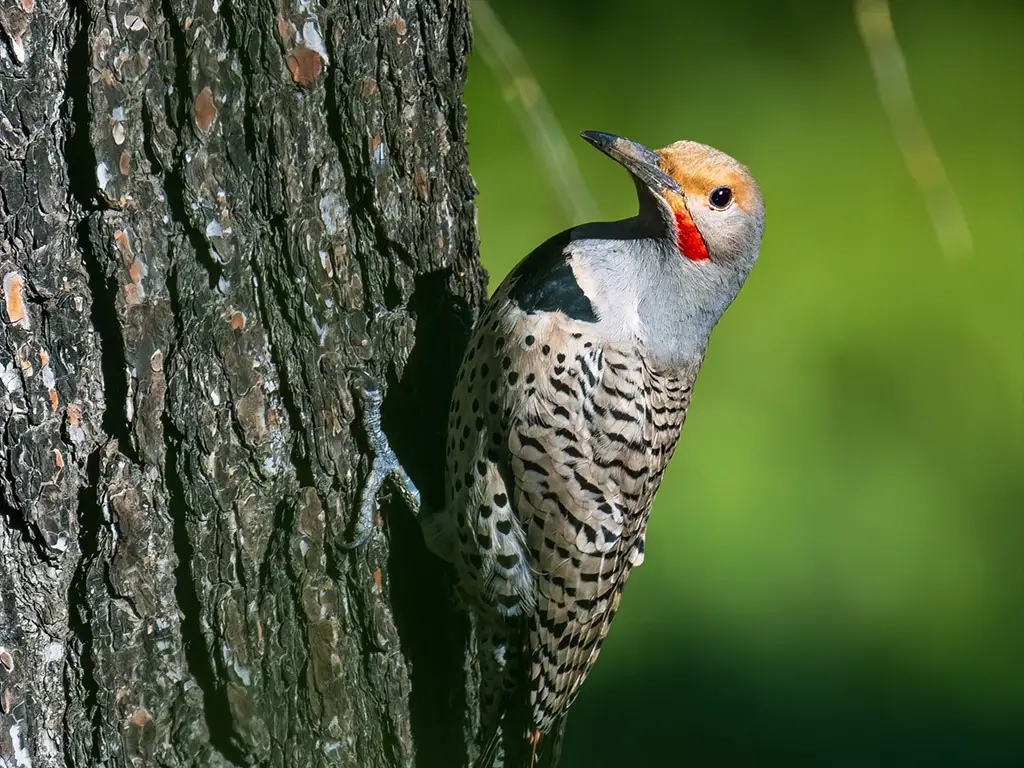
The Northern Flicker (Colaptes auratus) is a woodpecker species found across North America. Its distinguishing feature is its unique, spotted plumage, with yellow shafts on the undersides of the wings and tail.
Unlike many woodpeckers, Northern Flickers often forage on the ground, probing for ants and insects with their long, barbed tongues.
They also drum on dead trees and utility poles as part of their courtship ritual and territory marking. Their distinctive “wick-a-wick-a-wick” call adds an auditory element to their presence in woodlands and suburban habitats.
| Kingdom | Animalia |
| Phylum | Chordata |
| Clade | Dinosauria |
| Class | Aves |
| Order | Piciformes |
| Family | Picidae |
| Genus | Colaptes |
| Species | C. auratus |
24. Red-Winged Blackbird (Agelaius phoeniceus)
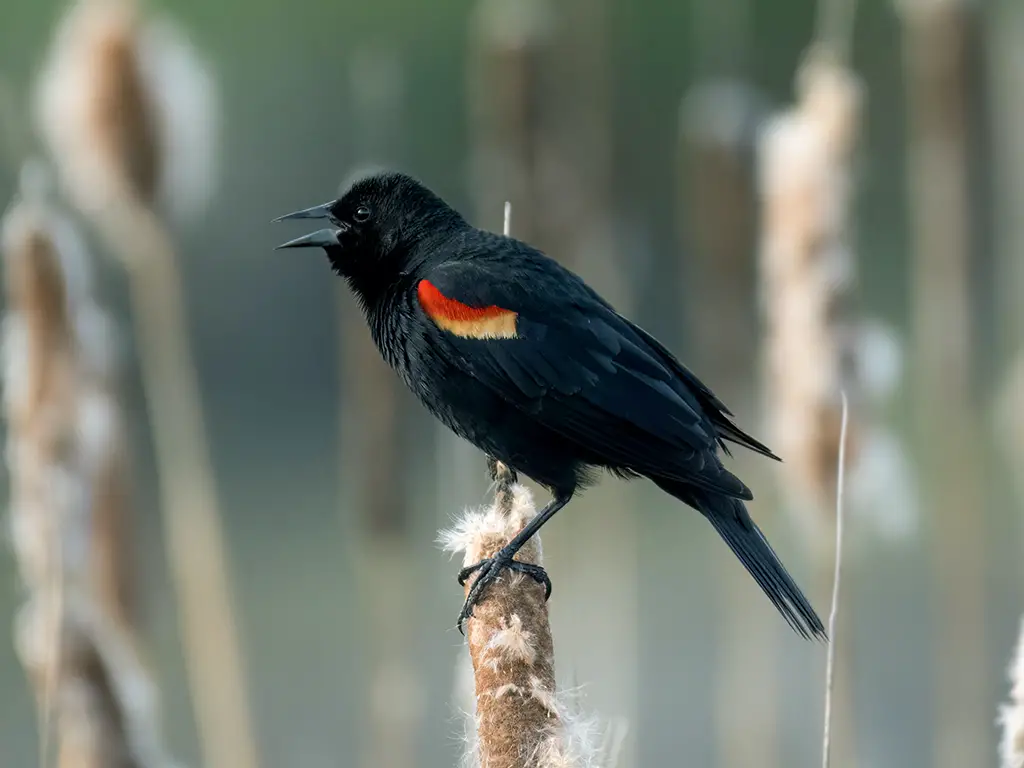
The Red-Winged Blackbird (Agelaius phoeniceus) is a common sight in wetlands, marshes, and fields across North America. Males are unmistakable with their glossy black plumage and vibrant red shoulder patches, which they use for territorial displays.
These birds have a harsh, distinctive call and are known for their nesting colonies. Red-winged blackbirds primarily feed on seeds and insects, and they often forage in flocks.
They are both bold and territorial, defending their territories with vigor. Their presence is a characteristic feature of wetland ecosystems and agricultural landscapes.
| Kingdom | Animalia |
| Phylum | Chordata |
| Clade | Dinosauria |
| Class | Aves |
| Order | Passeriformes |
| Family | Icteridae |
| Genus | Agelaius |
| Species | A. phoeniceus |
25. Common Grackle (Quiscalus quiscula)
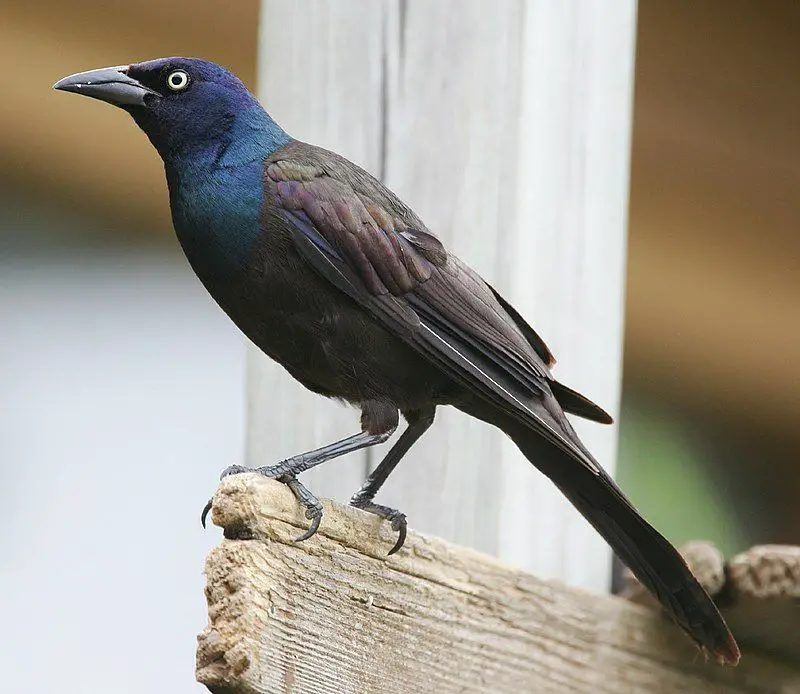
The Common Grackle is a striking bird known for its iridescent, metallic plumage that shimmers with hues of green and blue. These social birds are often found in flocks, foraging for a variety of foods such as insects, seeds, fruits, and human-provided scraps.
Common Grackles are notorious for their raucous calls and adaptability to urban environments. They have a distinctive “squeaky gate” call that can be heard in various habitats throughout their range.
Their bold and gregarious nature makes them a common sight at feeders and in open landscapes.
| Kingdom | Animalia |
| Phylum | Chordata |
| Clade | Dinosauria |
| Class | Aves |
| Order | Passeriformes |
| Family | Icteridae |
| Genus | Quiscalus |
| Species | Q. quiscula |
26. Carolina Wren (Thryothorus ludovicianus)
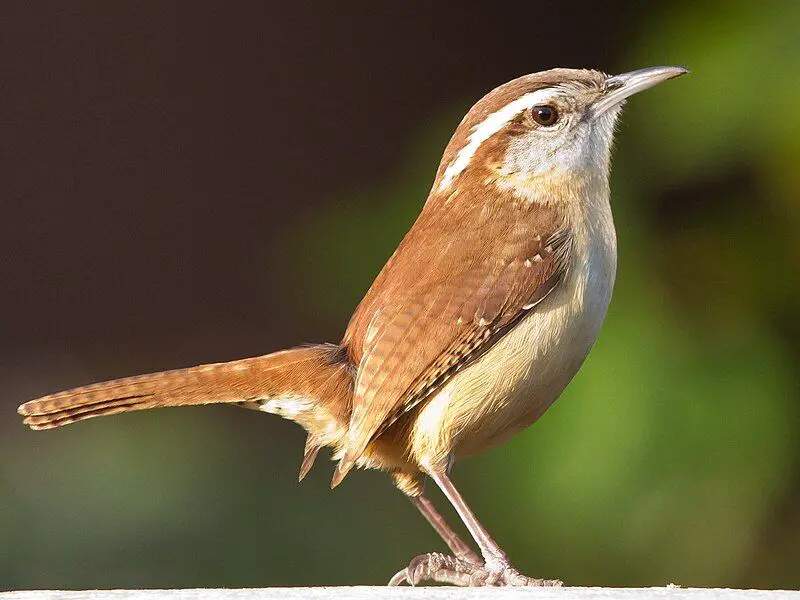
The Carolina Wren (Thryothorus ludovicianus) is a charming, small bird native to the southeastern United States. It boasts warm reddish-brown plumage, a white eyebrow stripe, and a distinctive upright tail.
These wrens are renowned for their loud and melodious songs, which they sing year-round, making them a delightful addition to gardens and woodlands. Carolina Wrens are expert foragers, searching for insects, spiders, and seeds in dense vegetation.
Their adaptable nature enables them to thrive in a variety of habitats, from forests to suburban gardens, where their cheerful presence and tuneful songs add to the joys of birdwatching.
| Kingdom | Animalia |
| Phylum | Chordata |
| Clade | Dinosauria |
| Class | Aves |
| Order | Passeriformes |
| Family | Troglodytidae |
| Genus | Thryothorus |
| Species | T. ludovicianus |
27. Pine Siskin (Spinus pinus)
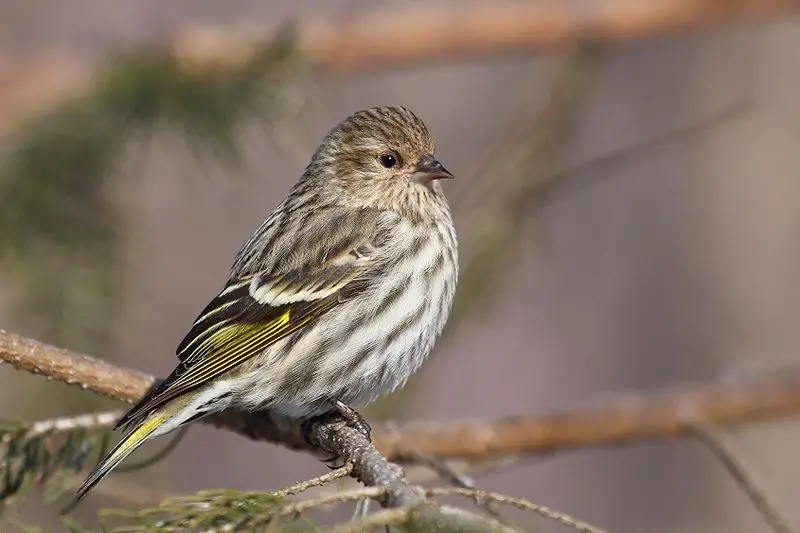
The Pine Siskin is a small, finch-like bird, primarily known for its streaky brown appearance. Measuring about 4-5 inches in length, it has a slender body with fairly pointed wings.
Its plumage is brown with heavy streaking all over, and it usually shows a touch of yellow in the wings and tail, which is more visible during flight. The bird’s bill is short and conical, typical of seed eaters.
Pine Siskins are often seen in flocks, especially around feeders, where they exhibit gregarious behavior. They are known for their twittering and buzzing calls.
| Kingdom | Animalia |
| Phylum | Chordata |
| Clade | Dinosauria |
| Class | Aves |
| Order | Passeriformes |
| Family | Fringillidae |
| Genus | Spinus |
| Species | S. pinus |
28. Brown-Headed Cowbird (Molothrus ater)
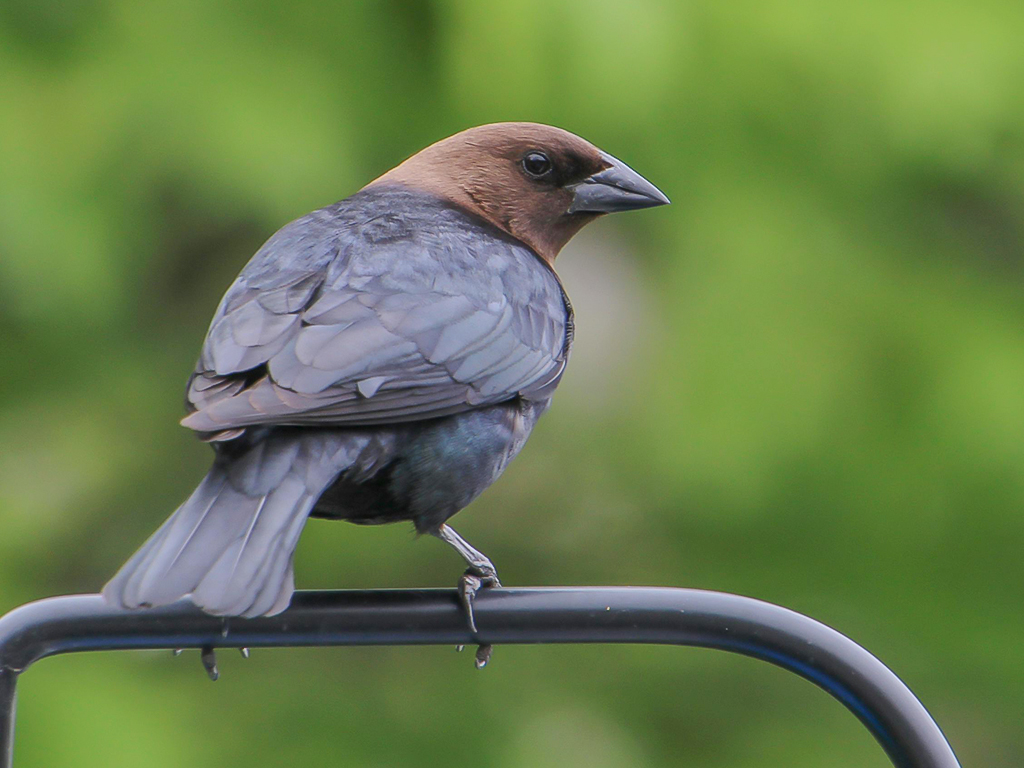
The Brown-Headed Cowbird is a medium-sized blackbird, notorious for its brood parasitism. Males are glossy black with a distinctive brown head, while females are duller with grayish-brown plumage.
They measure about 7-8 inches in length. The bird has a stout shape and a short tail. One of the most interesting aspects of the Brown-Headed Cowbird is its reproductive strategy; females lay eggs in the nests of other bird species, leaving the upbringing of their offspring to these unwitting foster parents.
They are often seen foraging on the ground, walking with a distinctive strut.
| Kingdom | Animalia |
| Phylum | Chordata |
| Clade | Dinosauria |
| Class | Aves |
| Order | Passeriformes |
| Family | Icteridae |
| Genus | Molothrus |
| Species | M. ater |
29. White-Crowned Sparrow (Zonotrichia leucophrys)
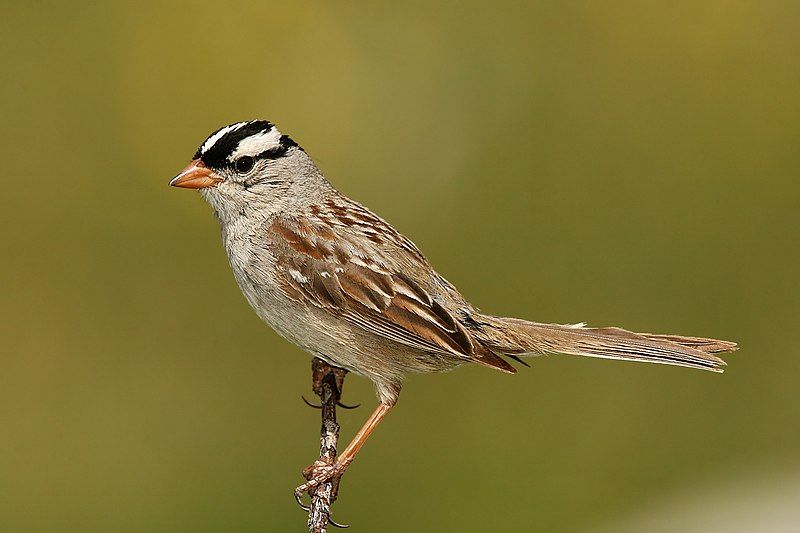
The White-Crowned Sparrow is a large, attractive sparrow, easily recognized by its striking head pattern. Adults have bold black and white stripes on their heads, a gray face, and a pale bill. They measure around 6-7 inches in length.
Their underparts are grayish with a subtle brownish tinge on the upper parts. Juveniles have brown and tan stripes on their heads, which makes them less conspicuous.
These birds are known for their clear, whistling songs. They are commonly found in shrubby habitats and often visit backyard feeders, especially in winter and during migration.
| Kingdom | Animalia |
| Phylum | Chordata |
| Clade | Dinosauria |
| Class | Aves |
| Order | Passeriformes |
| Family | Passerellidae |
| Genus | Zonotrichia |
| Species | Z. leucophrys |
30. Barred Owl (Strix varia)
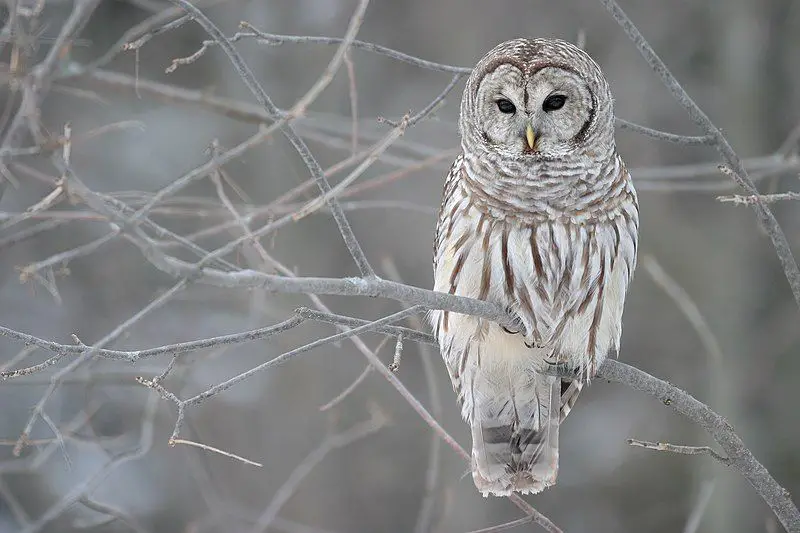
The Barred Owl is a large, round-headed owl known for its distinctive hooting call, often described as sounding like “Who cooks for you? Who cooks for you all?” It measures about 16-25 inches in length, with a wingspan of up to 44 inches.
The owl’s plumage is mottled brown and white, with vertical brown bars on the chest and horizontal brown bars on the belly, which give it its name.
Its eyes are dark brown, and it lacks ear tufts. Barred Owls are typically found in mature forests near water, and they are known for their stealthy hunting skills.
| Kingdom | Animalia |
| Phylum | Chordata |
| Clade | Dinosauria |
| Class | Aves |
| Order | Strigiformes |
| Family | Strigidae |
| Genus | Strix |
| Species | S. varia |
31. Sharp-Shinned Hawk (Accipiter striatus)
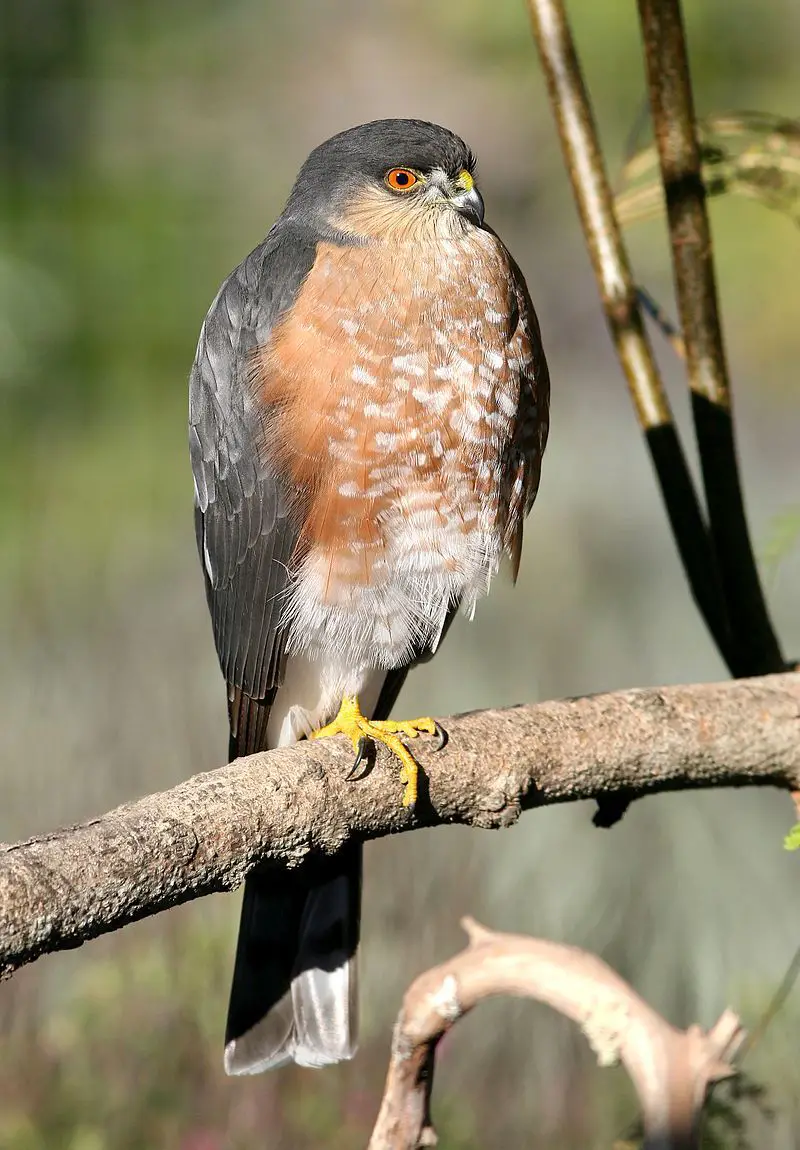
The Sharp-Shinned Hawk is the smallest in North America, measuring 9-13 inches in length with a wingspan of 16-22 inches. It has short, rounded wings and a long, narrow tail, which it uses to navigate through dense forests while hunting.
The adult has slate-gray upperparts and thin, horizontal red-orange bars on the underparts. Juveniles are browner with vertical streaks on the belly.
These hawks are known for their agile flying skills and are often seen darting through trees in pursuit of small birds, which are their primary prey.
| Kingdom | Animalia |
| Phylum | Chordata |
| Clade | Dinosauria |
| Class | Aves |
| Order | Accipitriformes |
| Family | Accipitridae |
| Genus | Accipiter |
| Species | A. striatus |
32. Yellow-Bellied Sapsucker (Sphyrapicus varius)
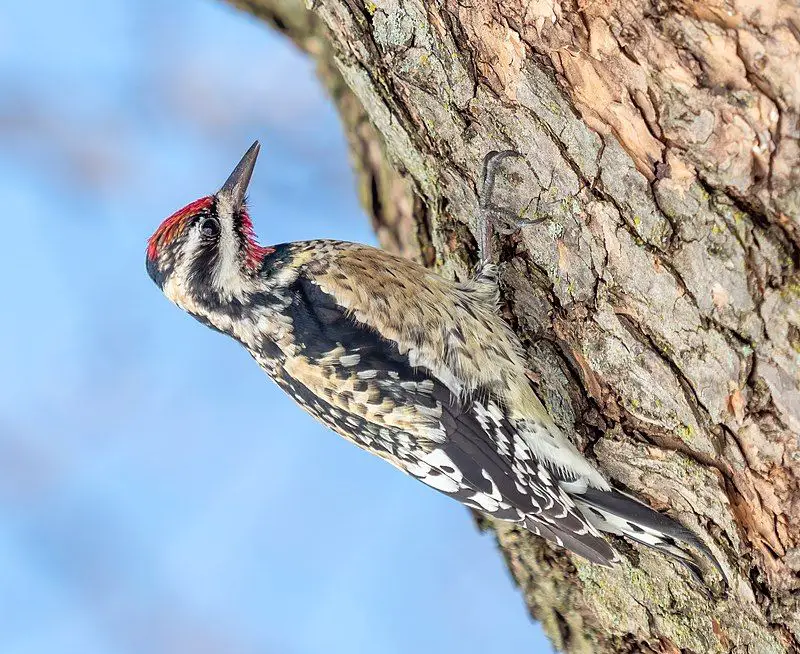
The Yellow-Bellied Sapsucker is a medium-sized woodpecker, about 7-8 inches in length, known for its unique feeding habits.
It has a striking black-and-white face pattern with a red forehead in both males and females; males also have a red throat while females have a white throat.
Its belly is pale yellow, which can be difficult to see. This bird drills organized rows of small holes in trees to sip the sap that flows out, and it also eats insects.
Yellow-bellied Sapsuckers migrate, spending summers in Canada and the northern United States, and winters in the southern United States, Central America, and the West Indies.
| Kingdom | Animalia |
| Phylum | Chordata |
| Clade | Dinosauria |
| Class | Aves |
| Order | Piciformes |
| Family | Picidae |
| Genus | Sphyrapicus |
| Species | S. varius |
33. Hooded Merganser (Lophodytes cucullatus)
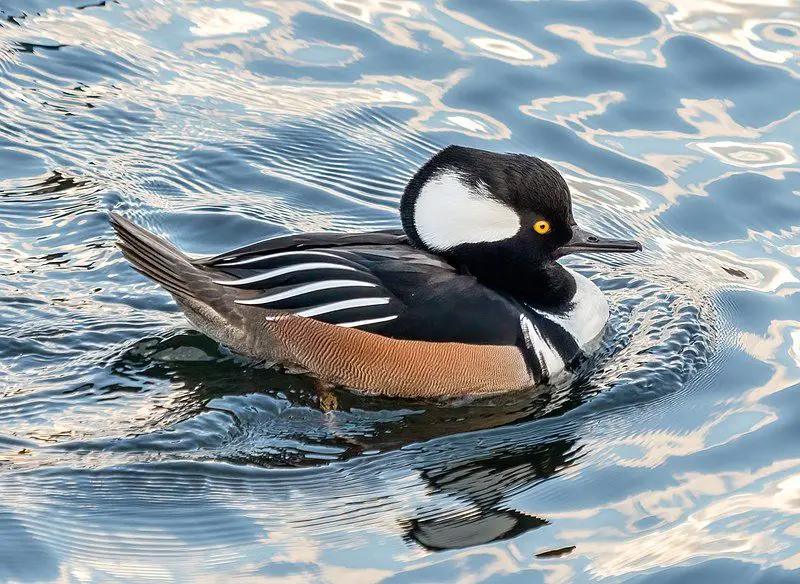
The Hooded Merganser is a striking small duck known for its distinctive crest. Males have a large white crest surrounded by black, which they can raise or lower. Their bodies are black and white with chestnut flanks.
Females are more subdued, with a gray-brown body and a smaller crest. Measuring about 16-19 inches in length, these ducks have a thin, serrated bill adapted for catching fish.
They are typically found in wooded ponds, lakes, and rivers and are known for their diving ability to catch prey underwater
| Kingdom | Animalia |
| Phylum | Chordata |
| Clade | Dinosauria |
| Class | Aves |
| Order | Anseriformes |
| Family | Anatidae |
| Genus | Lophodytes |
| Species | L. cucullatus |
34. Wood Duck (Aix sponsa)
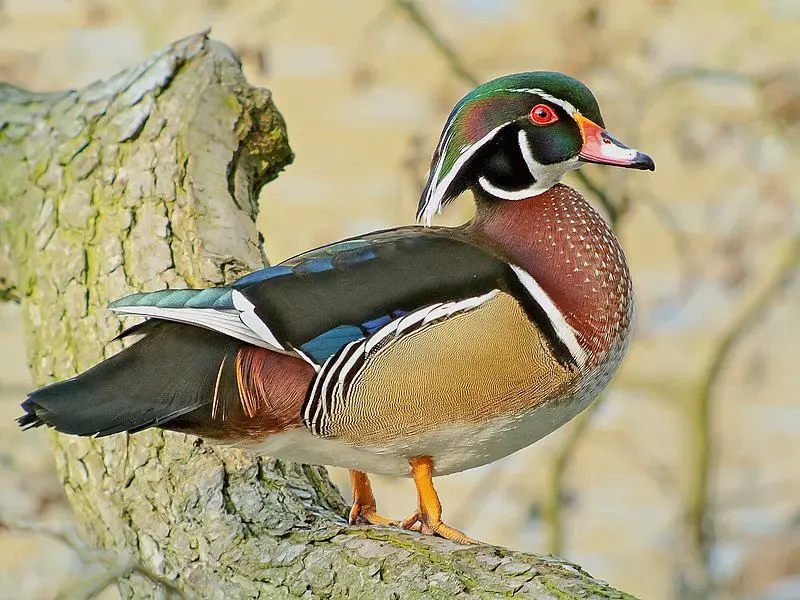
The Wood Duck is one of the most colorful North American waterfowl. Males have iridescent green and purple heads with striking white markings, a chestnut breast, and colorful flanks.
Females are less colorful, with gray-brown plumage and a distinctive white eye-ring. They measure around 18-21 inches in length.
Wood Ducks are unique among ducks in their nesting habits, as they nest in tree cavities near water. They are often seen in wooded swamps and marshes, and their diet consists of seeds, fruits, insects, and other small aquatic life.
| Kingdom | Animalia |
| Phylum | Chordata |
| Clade | Dinosauria |
| Class | Aves |
| Order | Anseriformes |
| Family | Anatidae |
| Genus | Aix |
| Species | A. sponsa |
35. Red-Tailed Hawk (Buteo jamaicensis)
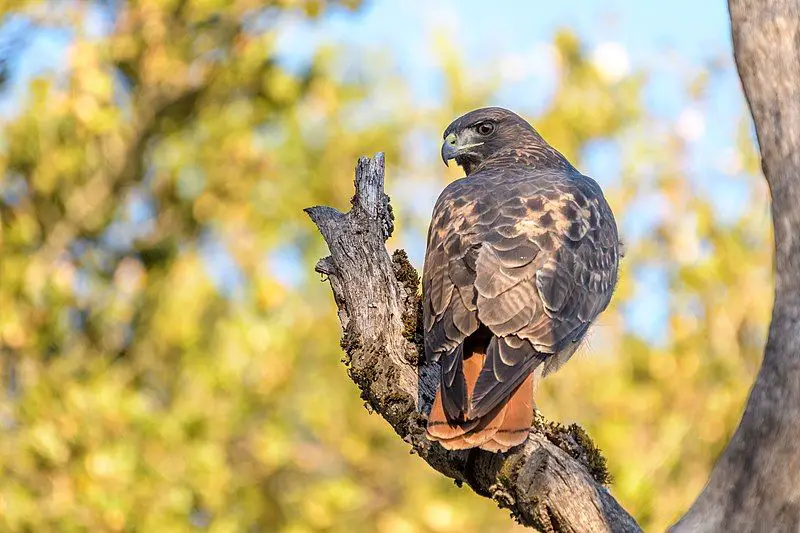
The Red-Tailed Hawk is a large bird of prey, well-known for its reddish-brown tail. It measures about 18-26 inches in length with a wingspan of up to 52 inches.
The plumage is generally brown above and pale below, with a streaked belly and a dark bar between the shoulder and wrist.
These hawks are adaptable and can be found in a wide range of habitats, including deserts, grasslands, forests, agricultural fields, and urban areas. They are known for their soaring flight and are often seen perched along highways or soaring over open fields.
| Kingdom | Animalia |
| Phylum | Chordata |
| Clade | Dinosauria |
| Class | Aves |
| Order | Accipitriformes |
| Family | Accipitridae |
| Genus | Buteo |
| Species | B. jamaicensis |
36. Northern Harrier (Circus hudsonius)

The Northern Harrier is a medium-sized raptor, unique for its owl-like facial disk and long, slender wings and tail. Males are gray above and white below with black wingtips, while females are brown with streaked plumage.
They measure about 16-20 inches in length. These birds are ground-nesters and are known for their low, gliding flight just above the ground in open fields and marshes, using their keen hearing and sight to locate prey.
Their diet mainly consists of small mammals and birds. The Northern Harrier is distinctive for its hunting style and is often seen in open, grassy environments.
| Kingdom | Animalia |
| Phylum | Chordata |
| Clade | Dinosauria |
| Class | Aves |
| Order | Accipitriformes |
| Family | Accipitridae |
| Genus | Circus |
| Species | C. hudsonius |
37. Great Black-Backed Gull (Larus marinus)
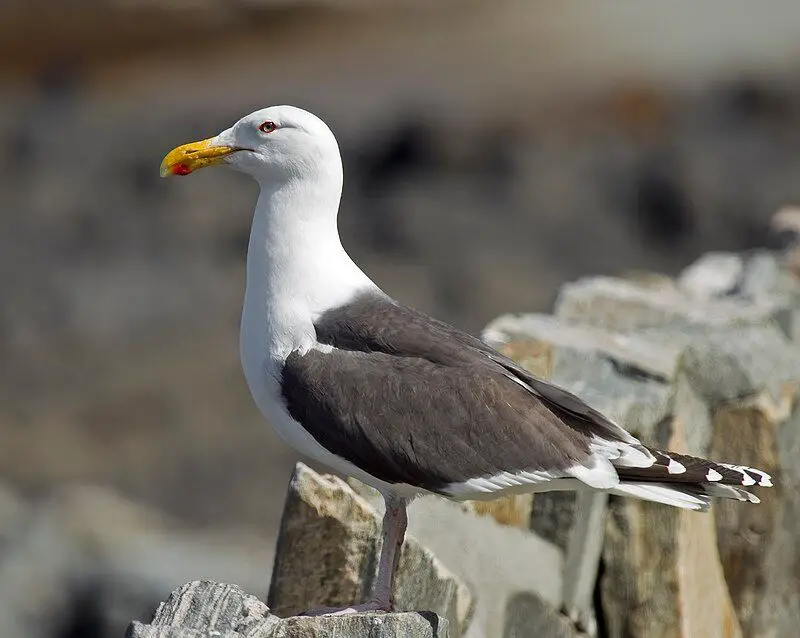
The Great Black-Backed Gull is the largest in the world, measuring about 28-31 inches in length with a wingspan of 5-6 feet. It has a powerful build with a heavy bill. Adults have striking black backs and wings, contrasting with their white underparts.
The head is also white, with bright yellow eyes and a large yellow bill with a red spot on the lower mandible. Juveniles are mottled brown and take four years to reach adult plumage.
They are apex predators among gulls, often seen preying on smaller birds, fish, and carrion. Great Black-Backed Gulls inhabit coastal regions and are known for their loud, deep calls.
| Kingdom | Animalia |
| Phylum | Chordata |
| Clade | Dinosauria |
| Class | Aves |
| Order | Charadriiformes |
| Family | Laridae |
| Genus | Larus |
| Species | L. marinus |
38. American Black Duck (Anas rubripes)
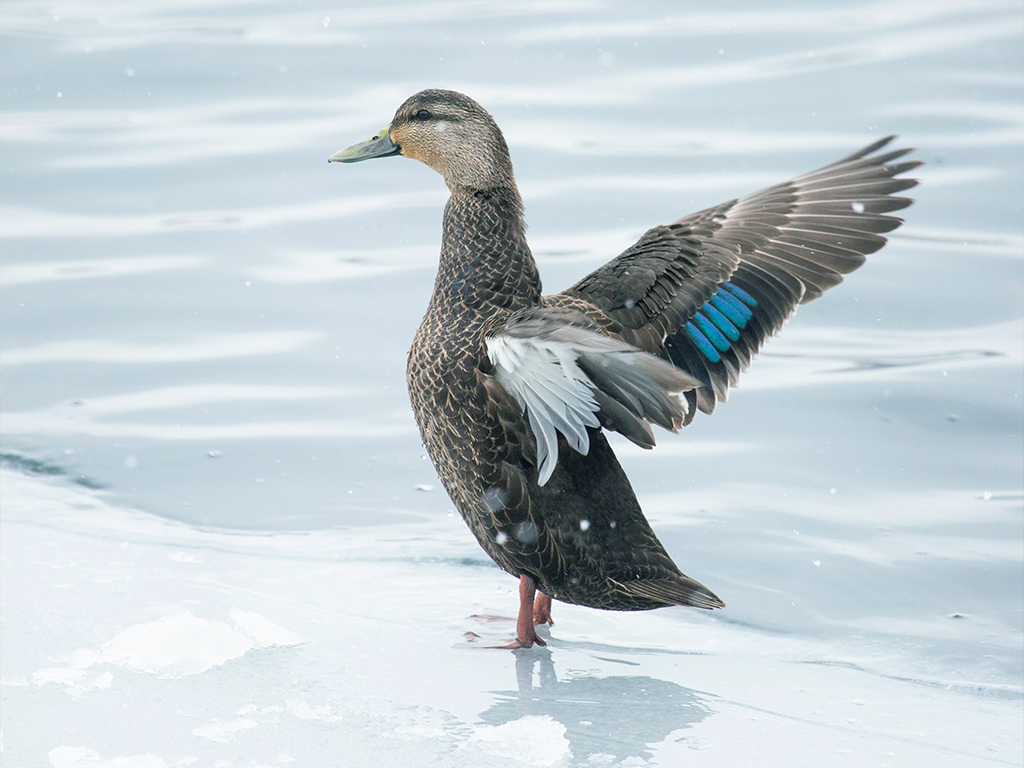
The American Black Duck is a large, dabbling duck, similar in size and shape to the Mallard, measuring about 21-23 inches in length. Despite its name, it is more dark brown than black, with paler brown on the head and neck.
The bird’s underwing is noticeably lighter, and the bill is yellow-green. American Black Ducks are often found in a variety of wetland habitats, including marshes, rivers, and coastal bays.
They feed by dabbling for plant material, small fish, and insects. This species has experienced a decline in numbers, partly due to habitat loss and hybridization with Mallards.
| Kingdom | Animalia |
| Phylum | Chordata |
| Clade | Dinosauria |
| Class | Aves |
| Order | Anseriformes |
| Family | Anatidae |
| Genus | Anas |
| Species | A. rubripes |
39. Red-Shouldered Hawk (Buteo lineatus)

The Red-Shouldered Hawk is a medium-sized hawk, known for its striking plumage and distinctive, keening call. They measure about 17-24 inches in length with a wingspan of about 3.5-4 feet.
Adults have rich, rufous-colored shoulders and a heavily barred chestnut and white chest and belly.
Their wings and tail have distinctive black and white banding. Juveniles are more muted in color. These hawks prefer deciduous forests, often near rivers or swamps.
They feed on small mammals, amphibians, and reptiles. The Red-Shouldered Hawk is known for its characteristic soaring flight with wings often held in a dihedral (V-shape).
| Kingdom | Animalia |
| Phylum | Chordata |
| Clade | Dinosauria |
| Class | Aves |
| Order | Accipitriformes |
| Family | Accipitridae |
| Genus | Buteo |
| Species | B. lineatus |
40. Bufflehead (Bucephala albeola)
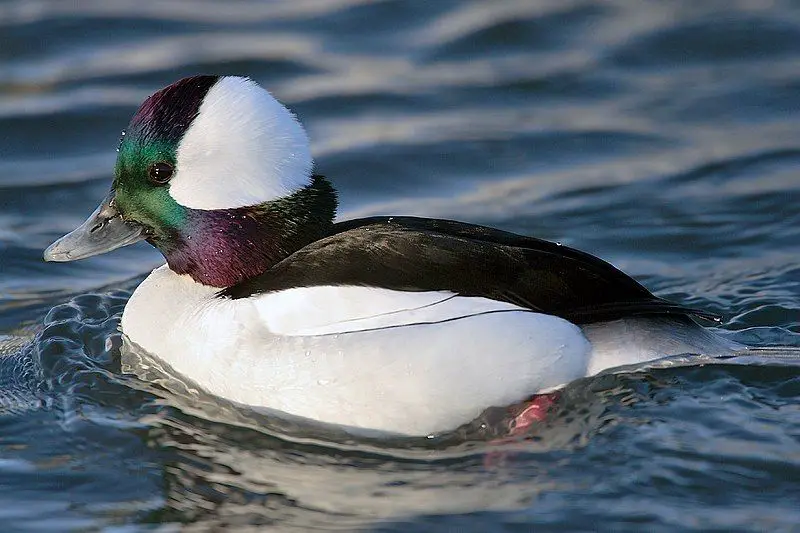
The Bufflehead is a small, buoyant diving duck, measuring about 13-16 inches in length with a wingspan of approximately 21 inches.
Male Buffleheads are unmistakable with their striking plumage – they have a large white patch that wraps around the back of the head and extends down the neck, contrasting sharply against their glossy black upper body.
The iridescence of the black plumage can show purple, green, and blue hues in different lights. Their bill is pinkish-white, and they have a compact, rounded body shape.
Females and juveniles are more subdued, with dark brown upper parts a smaller white cheek patch, and a dark gray bill. Buffleheads are agile swimmers and divers, feeding primarily on aquatic invertebrates.
They are unique among ducks in their nesting habits, as they prefer to nest in tree cavities, particularly those excavated by Northern Flickers. In the winter, they migrate to coastal bays and estuaries.
| Kingdom | Animalia |
| Phylum | Chordata |
| Clade | Dinosauria |
| Class | Aves |
| Order | Anseriformes |
| Family | Anatidae |
| Genus | Bucephala |
| Species | B. albeola |
41. Palm Warbler (Setophaga palmarum)
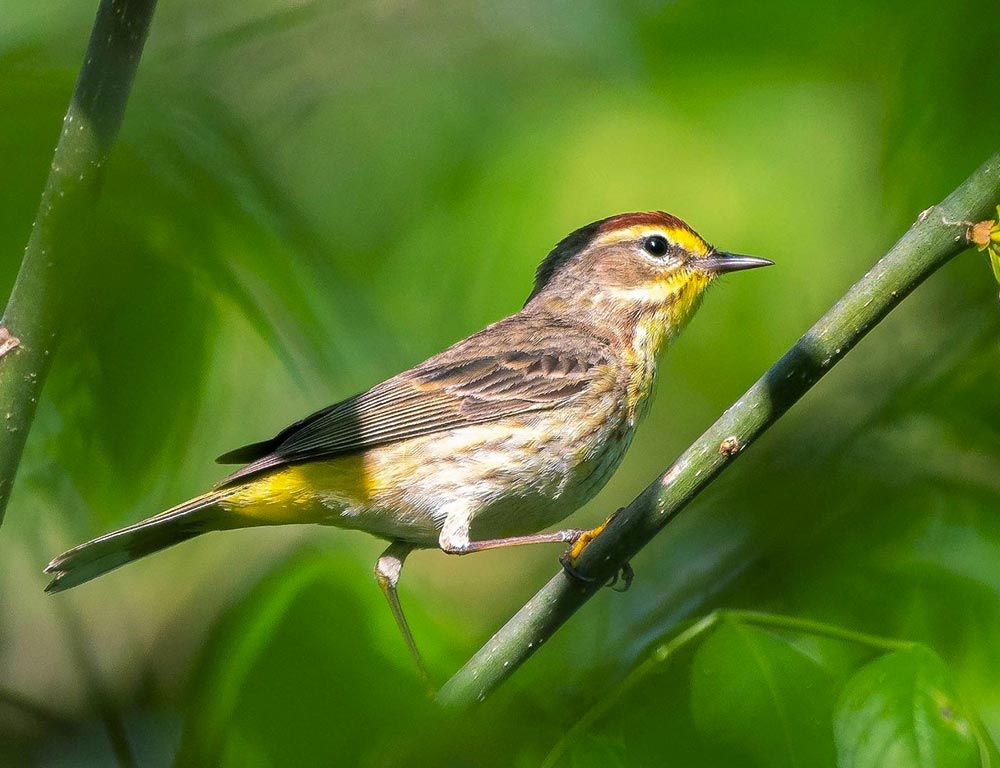
The Palm Warbler is a small, migratory songbird, measuring about 4.7-5.5 inches in length. It’s most recognizable by its constant tail bobbing and the rusty cap on its head.
There are two primary color morphs: the eastern “Yellow” Palm Warbler, which has bright yellow underparts and a chestnut cap, and the western “Western” Palm Warbler, which is more olive-brown with less yellow coloring.
Both morphs exhibit distinctive streaking on the breast and sides. Their wings are brown with faint wing bars. These warblers are among the first to arrive in the north in spring and the last to leave in the fall.
They breed in bogs and wetlands in Canada and the northeastern United States. Unlike many warblers, Palm Warblers spend a lot of time on the ground, where they forage for insects and berries. Their call is a weak “tsip.”
| Kingdom | Animalia |
| Phylum | Chordata |
| Clade | Dinosauria |
| Class | Aves |
| Order | Passeriformes |
| Family | Parulidae |
| Genus | Setophaga |
| Species | S. palmarum |
42. Snow Bunting (Plectrophenax nivalis)
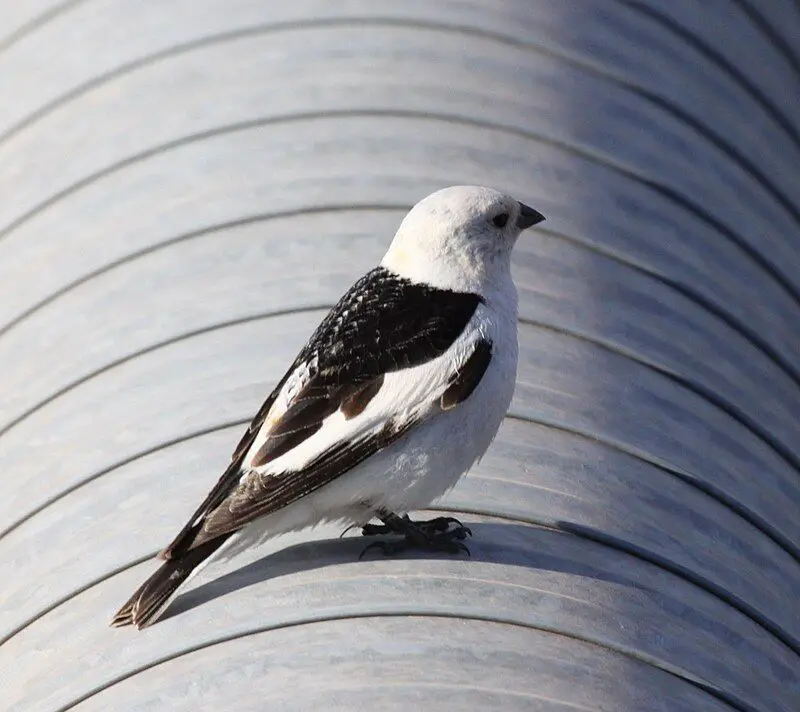
The Snow Bunting is a medium-sized songbird, known for its striking winter plumage and hardy nature. It measures about 6-7 inches in length with a wingspan of 12-14 inches.
In winter, males have predominantly white plumage with black back, wings, and tail. During the breeding season, their plumage becomes mostly black and white with a variable amount of rust color.
Females and juveniles are more brown and streaked but still show white in the wings and tail. Snow Buntings are birds of the high Arctic and are only seen in most of North America during the winter months.
They are ground feeders and primarily eat seeds, but during the summer, they also consume insects. Known for their hardiness, Snow Buntings breed in the extreme conditions of the high Arctic, often nesting in rock crevices. Their song is a pleasant, trilling warble, and their flight call is a clear, whistled “tew.”
| Kingdom | Animalia |
| Phylum | Chordata |
| Clade | Dinosauria |
| Class | Aves |
| Order | Passeriformes |
| Family | Calcariidae |
| Genus | Plectrophenax |
| Species | P. nivalis |
43. Great Horned Owl (Bubo virginianus)
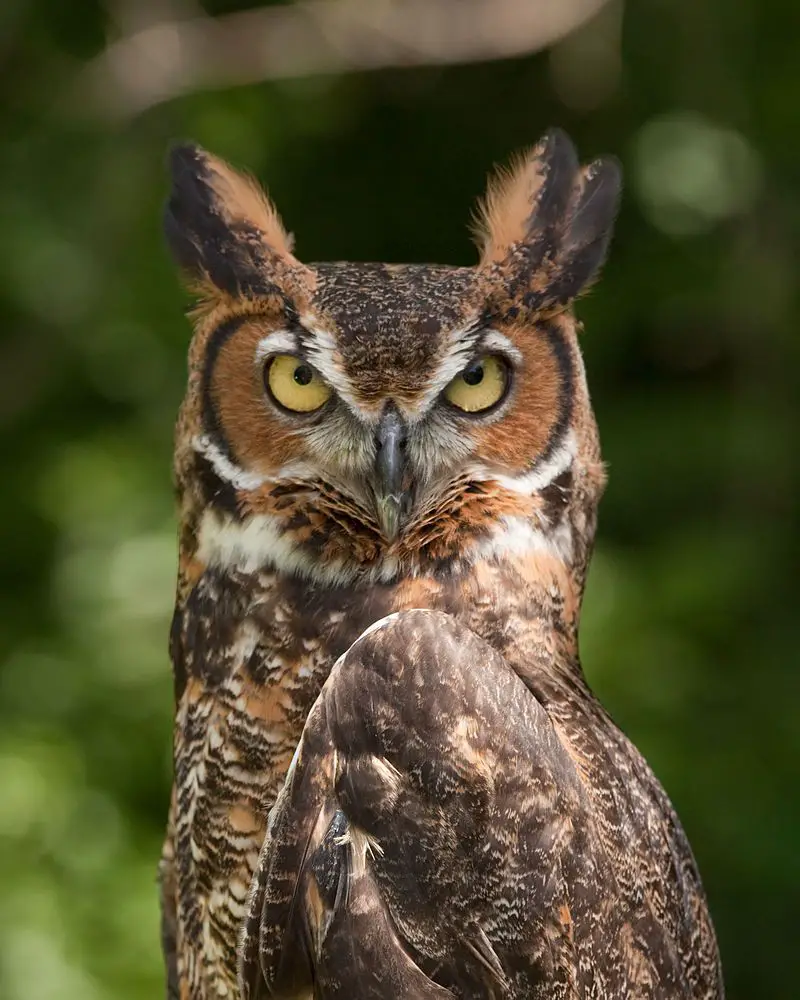
The Great Horned Owl is a large, powerful bird of prey, measuring about 18-25 inches in length with a wingspan of 3.3-4.8 feet. It is easily recognized by its large, tufted ears (or “horns”), which are just feathers.
The owl’s plumage is a mottled mix of brown, gray, and white, providing excellent camouflage in its forest habitat. It has piercing yellow eyes and a deep, hooting call, often associated with the mystery of the night.
Great Horned Owls are versatile hunters, preying on a wide range of animals, including rabbits, rodents, birds, and even skunks. They inhabit a variety of environments across North and South America, from forests and deserts to urban parks.
| Kingdom | Animalia |
| Phylum | Chordata |
| Clade | Dinosauria |
| Class | Aves |
| Order | Strigiformes |
| Family | Strigidae |
| Genus | Bubo |
| Species | B. virginianus |
44. Snowy Owl (Bubo scandiacus)
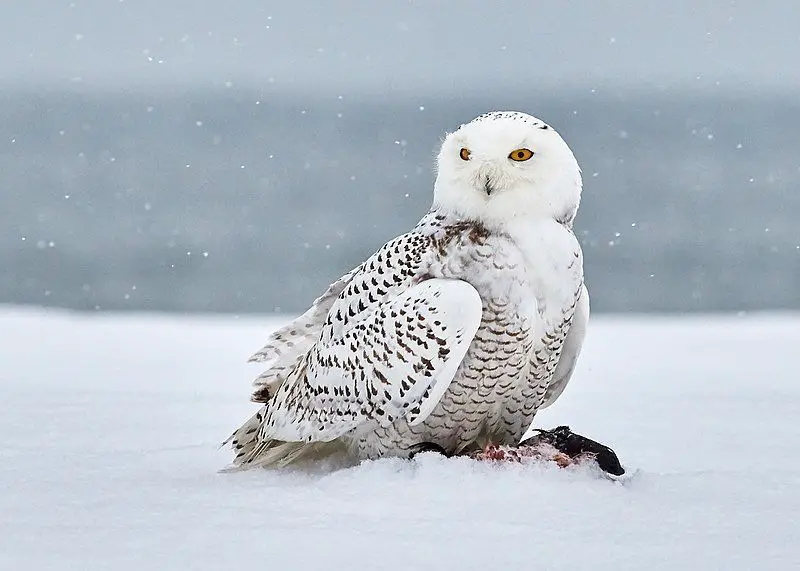
The Snowy Owl is a large, majestic bird, famous for its striking white plumage that provides camouflage in its Arctic habitat. It measures about 20-28 inches in length with a wingspan of 4.2-4.8 feet.
The males are almost pure white, while females and young birds have more dark flecks and bars. These owls have large, round heads with no ear tufts and bright yellow eyes.
Snowy Owls are diurnal, unlike most other owls, and are known for their endurance in the harsh Arctic environment. They primarily feed on small mammals, especially lemmings.
During the winter, some migrate southward, occasionally appearing in southern Canada and the northern United States.
| Kingdom | Animalia |
| Phylum | Chordata |
| Clade | Dinosauria |
| Class | Aves |
| Order | Strigiformes |
| Family | Strigidae |
| Genus | Bubo |
| Species | B. scandiacus |
45. Sandhill Crane (Antigone canadensis)
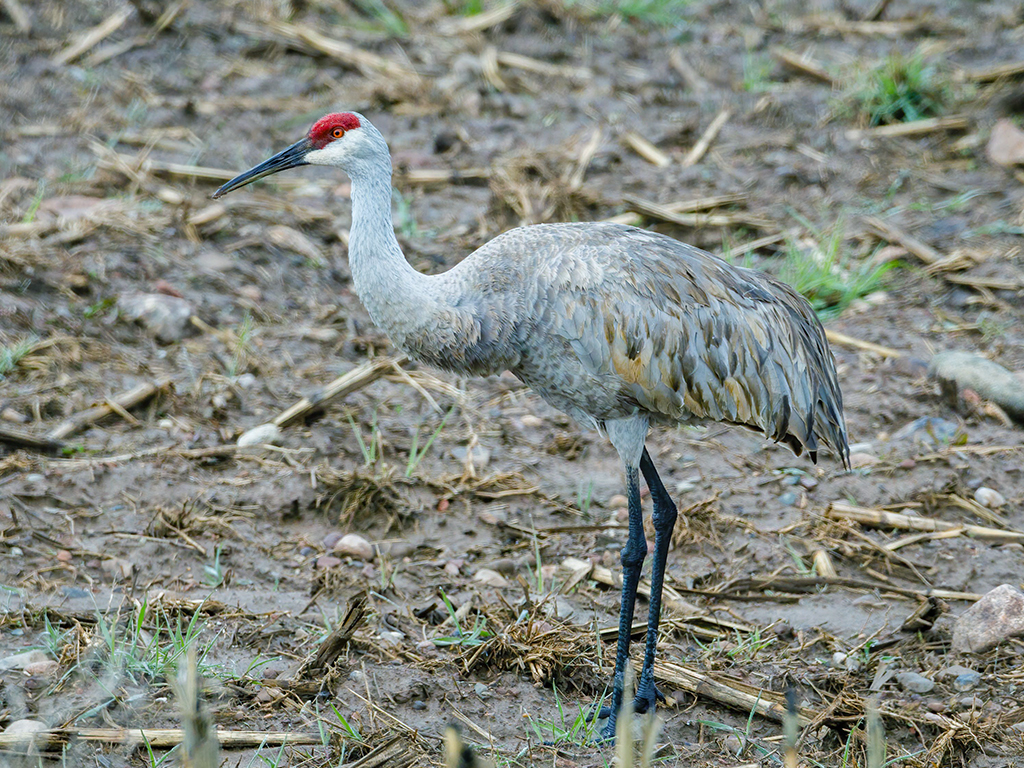
The Sandhill Crane is a tall, elegant bird, standing about 3-4 feet tall with a wingspan of 5-6 feet. It has a gray plumage, which can appear rusty in some lights due to preening with mud.
One of its distinguishing features is a bright red patch on its forehead. These cranes have long, slender necks, legs, and a straight, pointed bill.
They are known for their spectacular courtship dances, which include bowing, jumping, and wing flapping. Sandhill Cranes are migratory, breeding in northern parts of North America and Siberia, and wintering in the southern United States and Mexico.
They emit a loud, trumpeting call, often heard in flight or during their elaborate mating rituals.
| Kingdom | Animalia |
| Phylum | Chordata |
| Clade | Dinosauria |
| Class | Aves |
| Order | Gruiformes |
| Family | Gruidae |
| Genus | Antigone |
| Species | A. canadensis |
Conclusion
Winter birds in Rhode Island bring an added sense of beauty and wonder to the state’s natural landscape during the colder months. These resilient creatures brave harsh weather conditions and adapt their behaviors to survive and thrive in this challenging season.
Whether it is the vibrant plumage of the cardinal, the playful acrobatics of the chickadee, or the majestic presence of the snowy owl, winter birdwatching in Rhode Island offers a unique and rewarding experience for nature enthusiasts.
Maintaining and protecting the habitats and food sources for these birds is crucial to their survival, and we must continue to support conservation efforts to ensure that future generations can enjoy the mesmerizing presence of winter birds in Rhode Island.